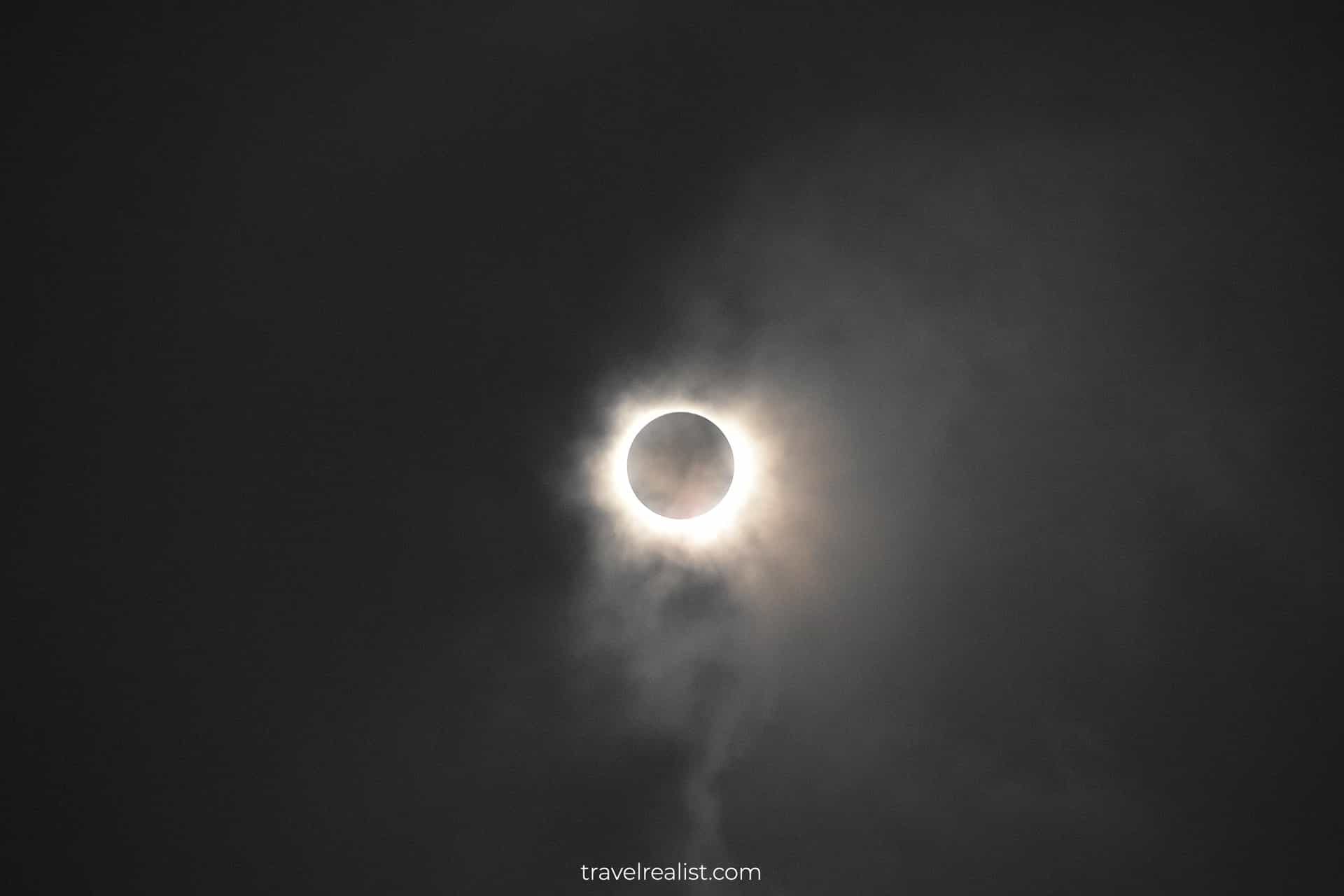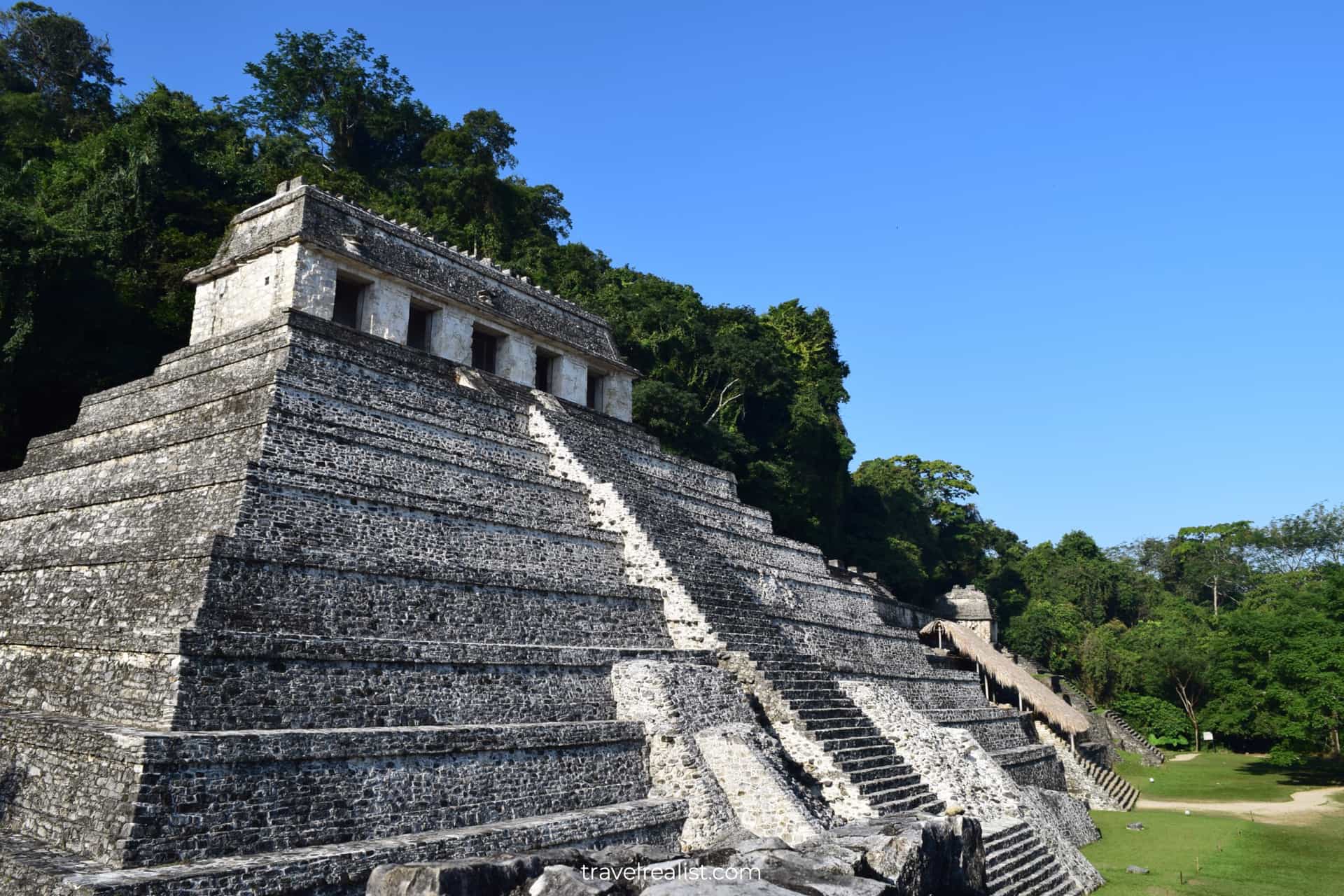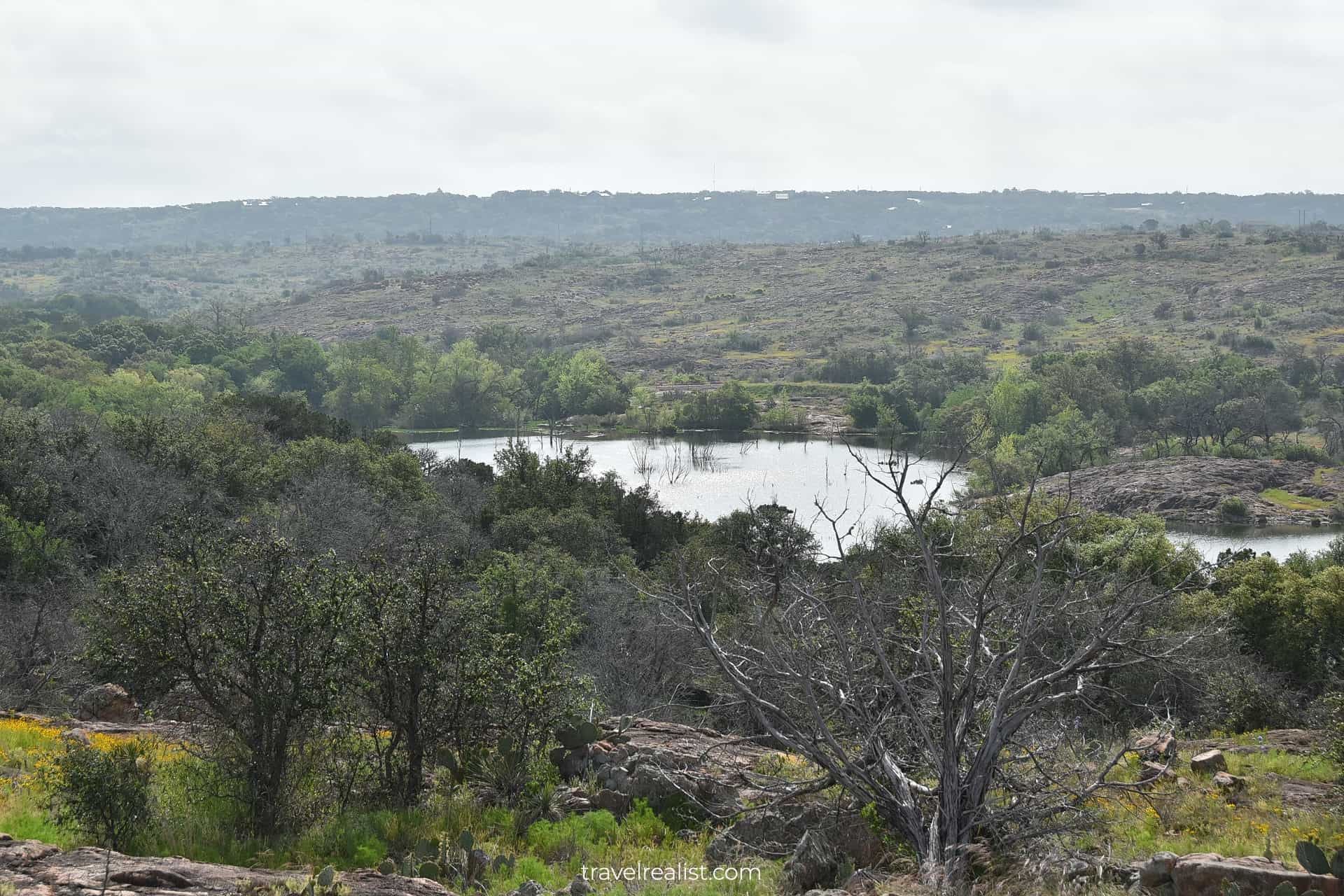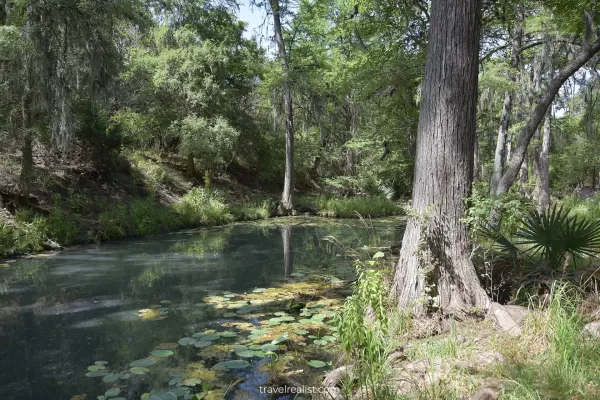Chicago Architecture Guide: Walking Tours, River & Lake Cruises
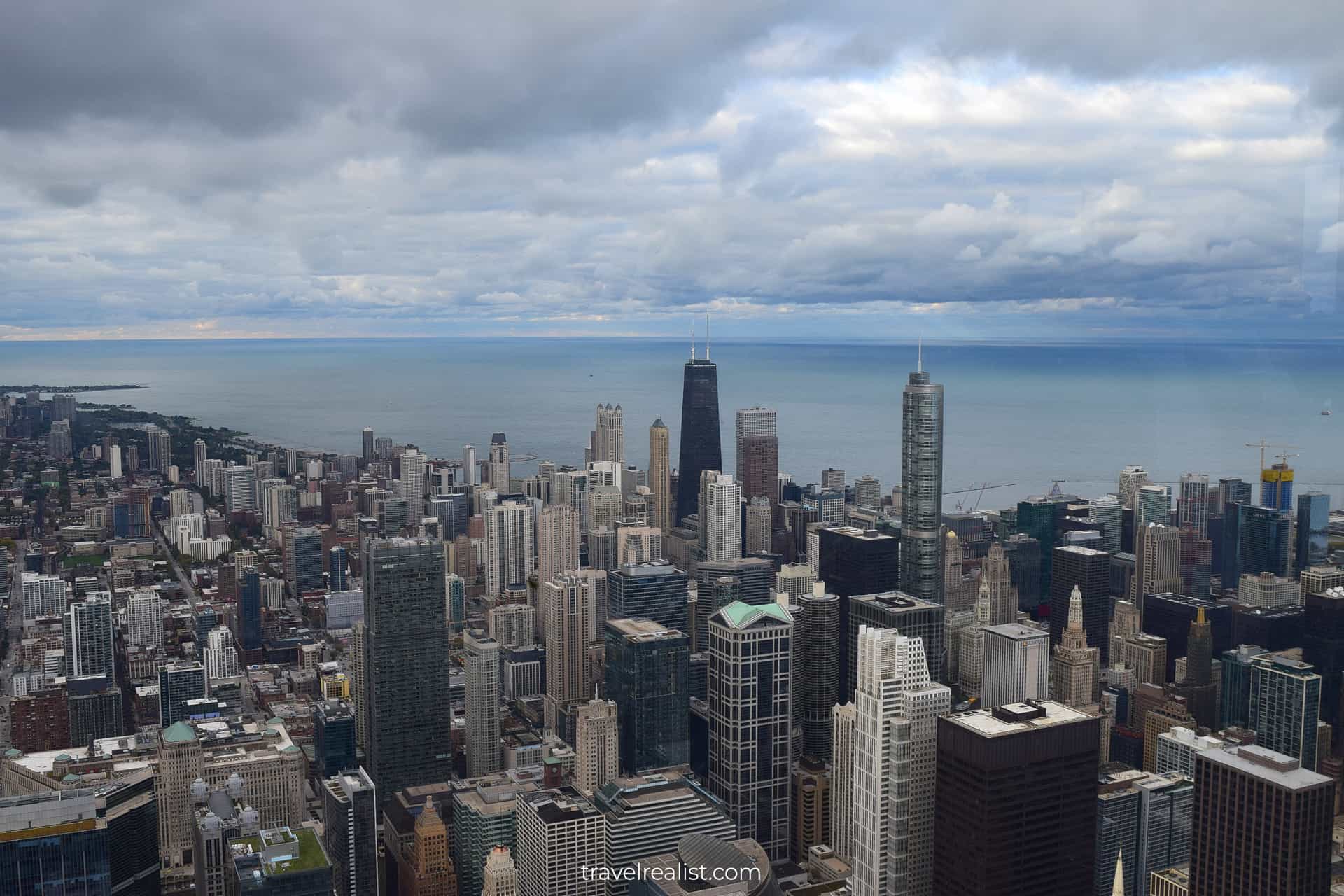
This realistic and comprehensive Chicago Architecture Guide helps you plan your next adventure in “The Windy City”.
Chicago, Illinois is the third largest metro area in the United States. The city on the shore of Lake Michigan has been long known for its stunning architecture and prominent skyline.
- Sights & Places of Interest
- 1. Chicago Architecture Walking Tour
- 2. Chicago Architecture River Cruise
- 2.1. DuSable Bridge
- 2.2. London Guarantee Building
- 2.3. Jewelers Building
- 2.4. Clark Street Bridge
- 2.5. Reid, Murdoch & Co. Building
- 2.6. Merchandise Mart
- 2.7. Kinzie Street Railroad Bridge
- 2.8. Constellation Sculpture
- 2.9. Civic Opera House
- 2.10. Willis Tower
- 2.11. Monroe Street Bridge
- 2.12. Wrigley Building
- 2.13. Tribune Tower
- 3. Lake Michigan Architecture Cruise
- 4. Hyde Park Architecture Tour by Train
- Getting to Chicago
- Where to Stay to See Chicago Architecture
- Entrance Requirements & Passes
- Takeaways: Chicago Architecture
This post includes affiliate links that will earn us commission if you make a purchase via these links.
Sights & Places of Interest
Chicago area is home to some 9 million people. The city welcomes another 49 million visitors each year. A good number of them come to Chicago to admire its gorgeous buildings.
There are a few different ways to explore Chicago architecture. Your preferences on mode, time, and budget are the only factors that could influence your decision.
You could take a self guided walking tour next to the Art Deco, Gothic, Neo-Classical, and modern structures. A river cruise will bring you to the historic buildings visible from the Chicago River.
A Lake Michigan cruise will give you a different angle to admire the city skyline. And a train ride to Hyde Park will reveal the masterpieces from the turn of the 19th and 20th century.
This Chicago Architecture Comprehensive Guide discusses all of the ways to see the city in detail. It starts with a Walking Tour, moves to a River and Lake Cruise, and closes with a Hyde Park walk.
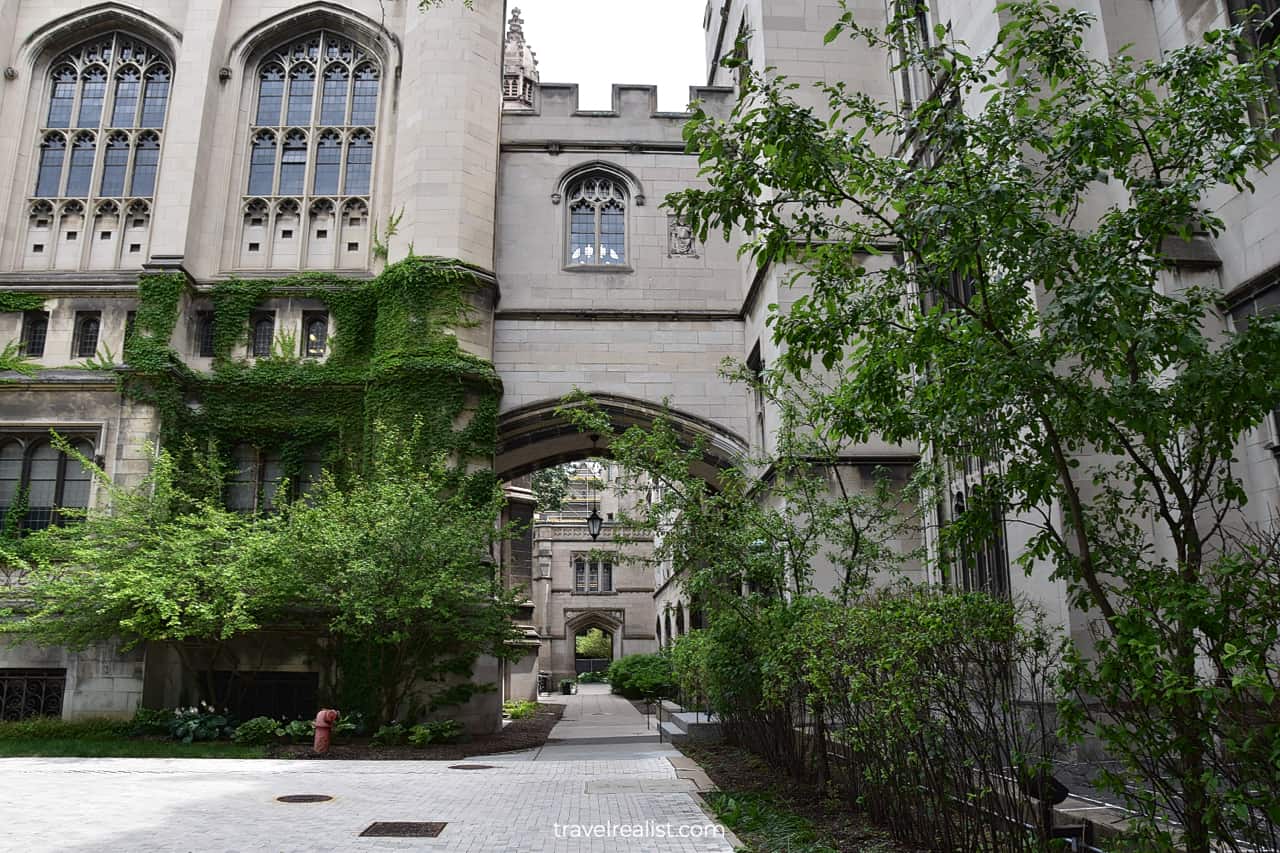
1. Chicago Architecture Walking Tour
There is no better way to explore Chicago Architecture than on a free walking tour. This way, you could interact with the pathways, parks, and buildings as a local.
The Chicago Loop is a perfect starting point for such a tour. It is an iconic area of the city. The Loop is home to the tallest towers, historic buildings, and vibrant parks.
You could reach the Loop on every subway and train line. A handful of bus routes go through this neighborhood. And the Loop is very bike friendly thanks to its well designed bike lanes.
A walking tour could take under 2 miles (3 km) if you only explore Millenium Park and Grant Park. You would need to cover nearly 3 miles (4.5 km) if you decide to visit the Willis Tower.
You are looking at 4+ miles (6+ km) of walking if you choose to explore Shedd Aquarium. The same is true if you add the buildings of the Near North Side or Navy Pier.
Remember to use public transport as you admire the city. Subway, trains, buses, and bikes could save you a lot of time when traveling between the famous structures.
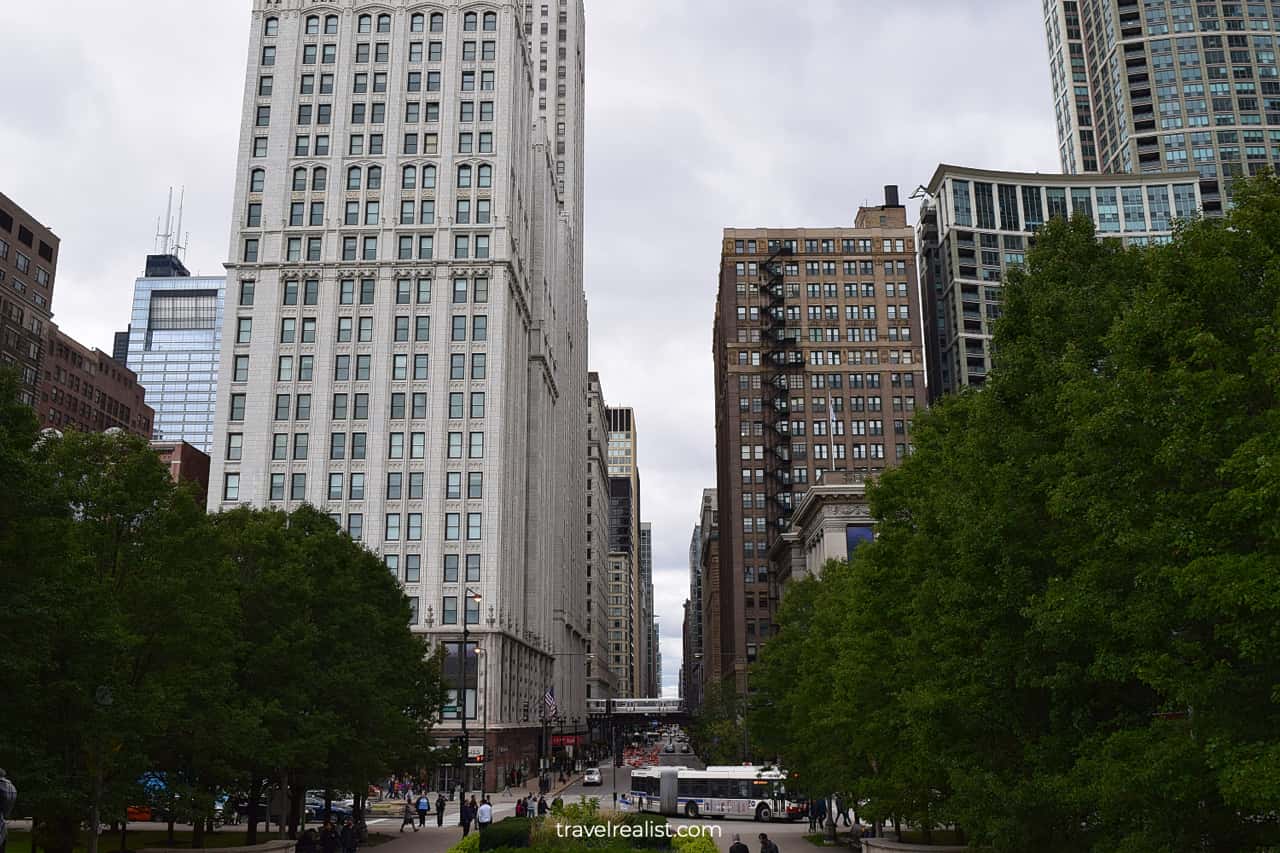
1.1. Millennium Park
You should first take Michigan Avenue, the main street of the city, to Millenium Park. The park is just a short walk from Millennium, State/Lake, Lake, and Washington/Wabash stations.
The name of Millennium Park points to its opening date. The park is a newer addition to the city. It opened in the 21st century.
But it has since developed into one of the main sights of Chicago. A central location, a thoughtful design, and lots of greenery are to thank for this development.
The Millenium Monument at Wrigley Square should be your first stop in Millennium Park. It is a 2002 replica of the 1917 original peristyle.
The original did not stand the test of time and was demolished in 1953. The replica is a link between generations.
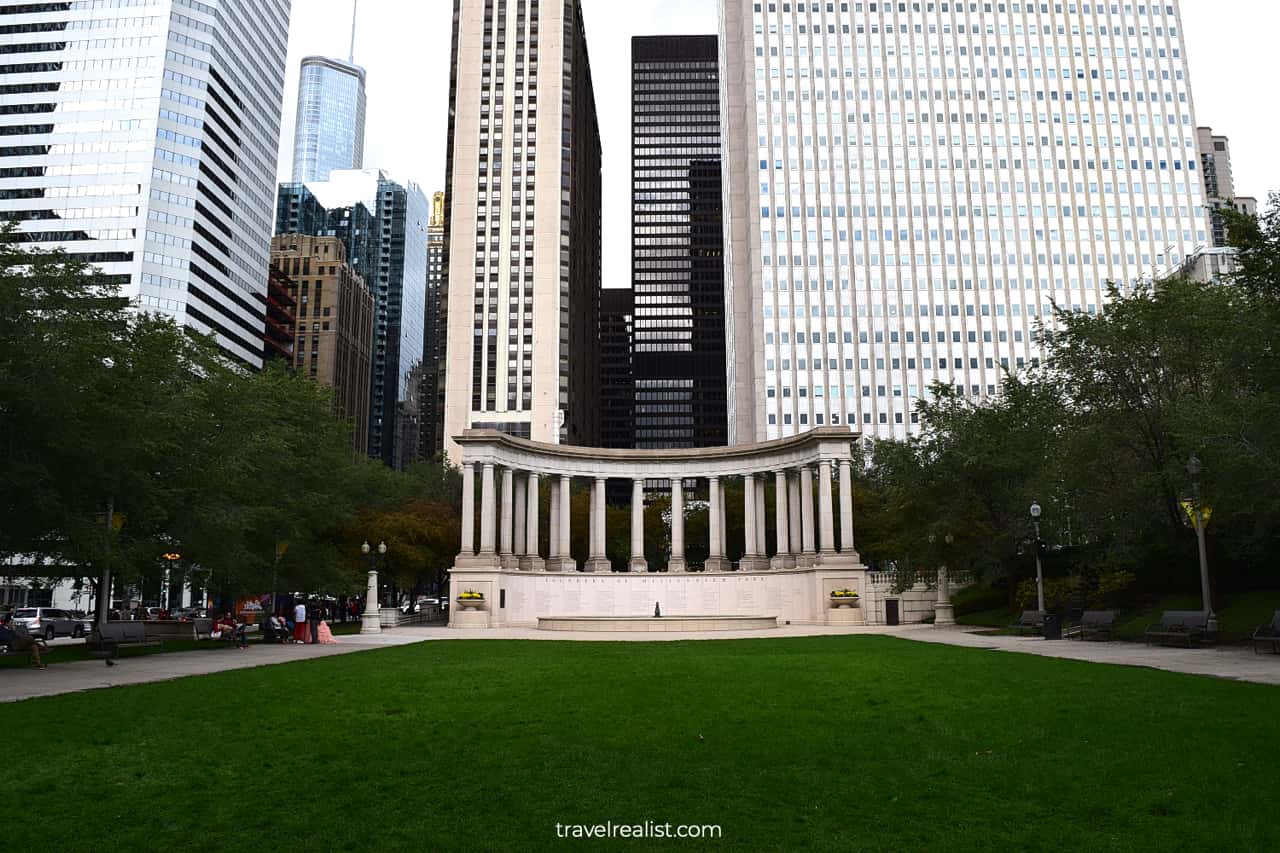
1.2. Cloud Gate
You should continue your walk through the park. You will soon reach Cloud Gate. It is about a block south of the Millennium Monument.
A handful of people use the nickname “The Bean” when referring to Cloud Gate. This bean shaped stainless steel sculpture has become the symbol of Chicago.
“The Bean” is a great place to get reflections of the city skyline. This is the main reason tourists come to Cloud Gate. It is one of the most visited attractions in the city.
But crowds make it difficult to enjoy the moment at “The Bean”. Unless you visit it at sunrise, you might not find your visit enjoyable.
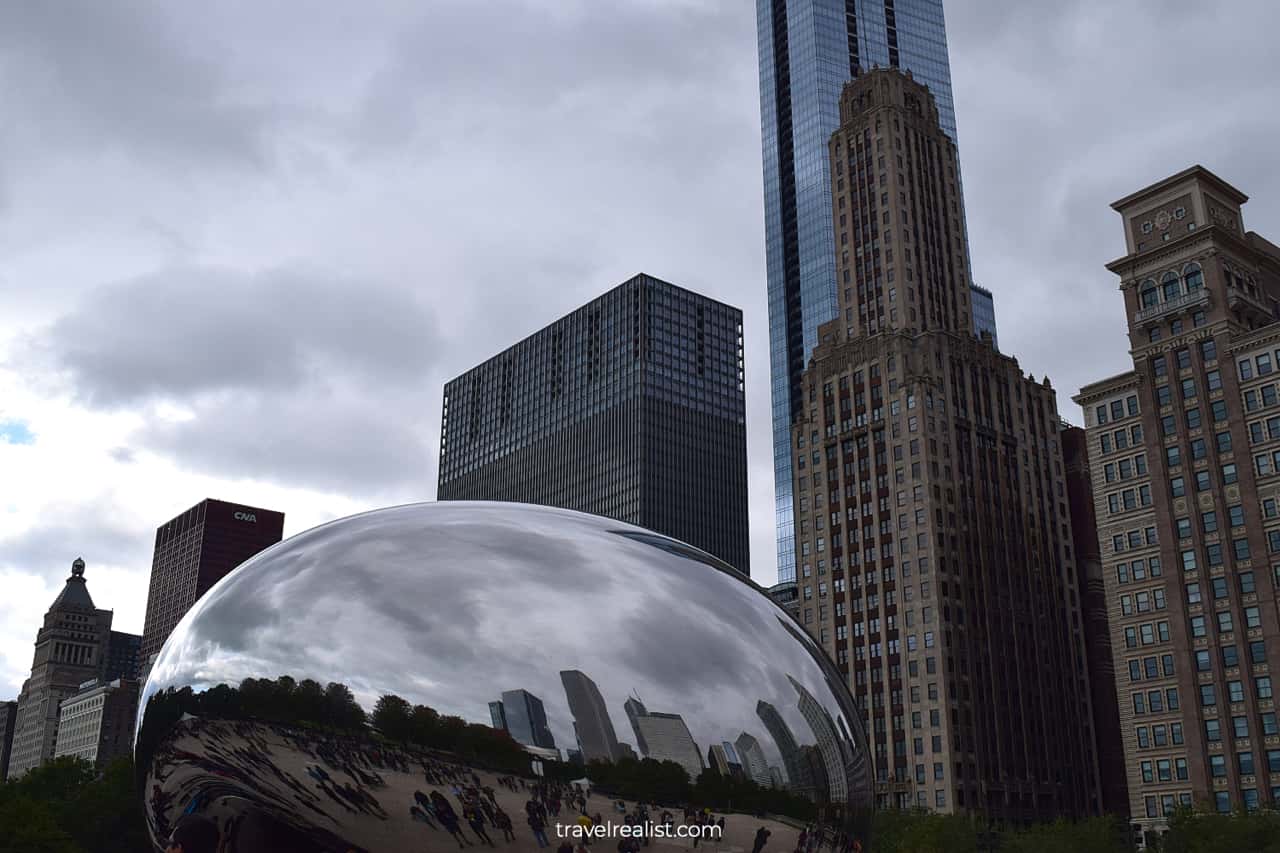
1.3. Jay Pritzker Pavilion
Jay Pritzker Pavilion is just east of Cloud Gate. The Pavilion hosts concerts and performing arts events. It has enough space for up to 11,000 people.
The Pavilion is home to the Grant Park Music Festival. This is the only annual free classical concert series in the United States.
You could explore the Pavilion freely unless there is a concert taking place later that day. Do not miss your chance to see the headdress. It is there to help with the acoustics.
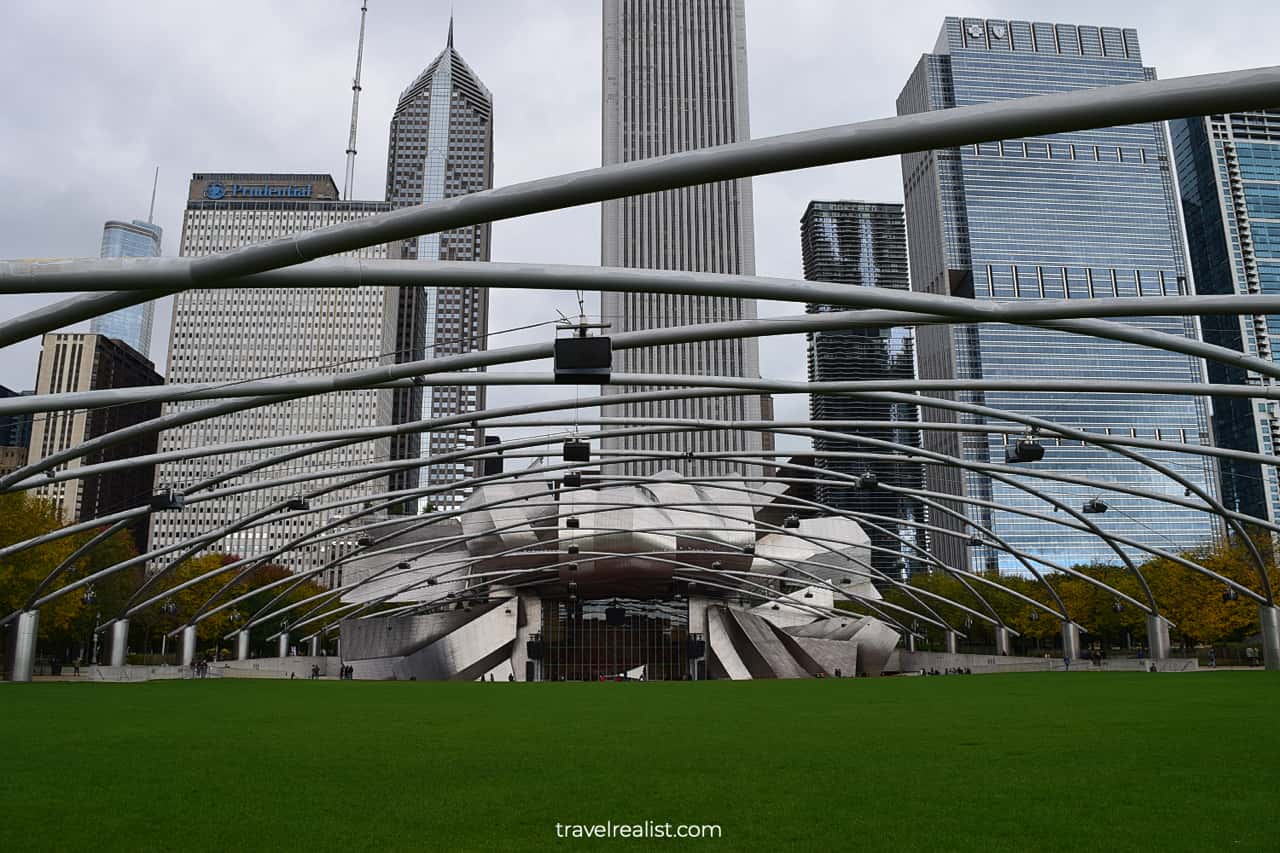
1.4. Buckingham Fountain
Buckingham Fountain in Grant Park should be your next stop on the Chicago Architecture Walking Tour. It is one of the largest fountains in the world. This symmetrical fountain dates back to 1927.
It operates from May to mid October. You could count on catching a light show if you visit Buckingham Fountain in the evening. These fountain light shows resemble Bellagio Fountain in Las Vegas.
If you visit Chicago in the winter, you could enjoy light decorations at Buckingham Fountain. This gives you another reason to see it during any time of the year.
There is a way to get a picture of Buckingham Fountain with the Willis Tower in the distance. You just need to stand at the southeast corner of the fountain with Lake Shore drive behind you.
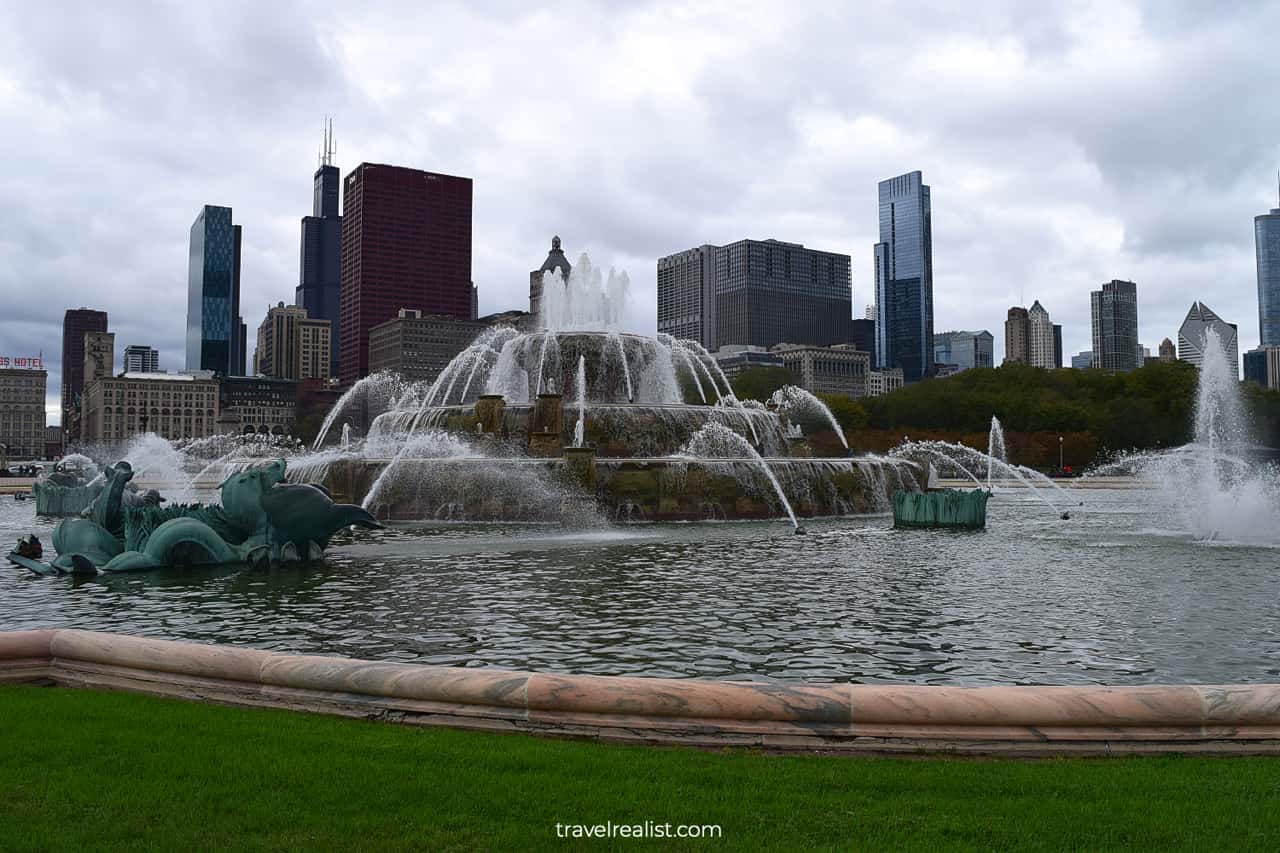
1.5. Shedd Aquarium
Buckingham Fountain is fairly close to Lake Michigan. You just need to cross Lakeshore Drive to be at the lakeshore. It could be a good idea to stroll on the paved Lakefront Trail.
Shedd Aquarium is good destination for this lakeshore walk. This building opened in 1930. It is the third largest aquarium in the United States.
Shedd Aquarium is a scenic building. Its exterior is far more beautiful than the New England Aquarium in Boston and the National Aquarium in Baltimore.
Your next stop on the walking tour is a bit further away. You might want to take a subway, bus, or bike to the Willis Tower.
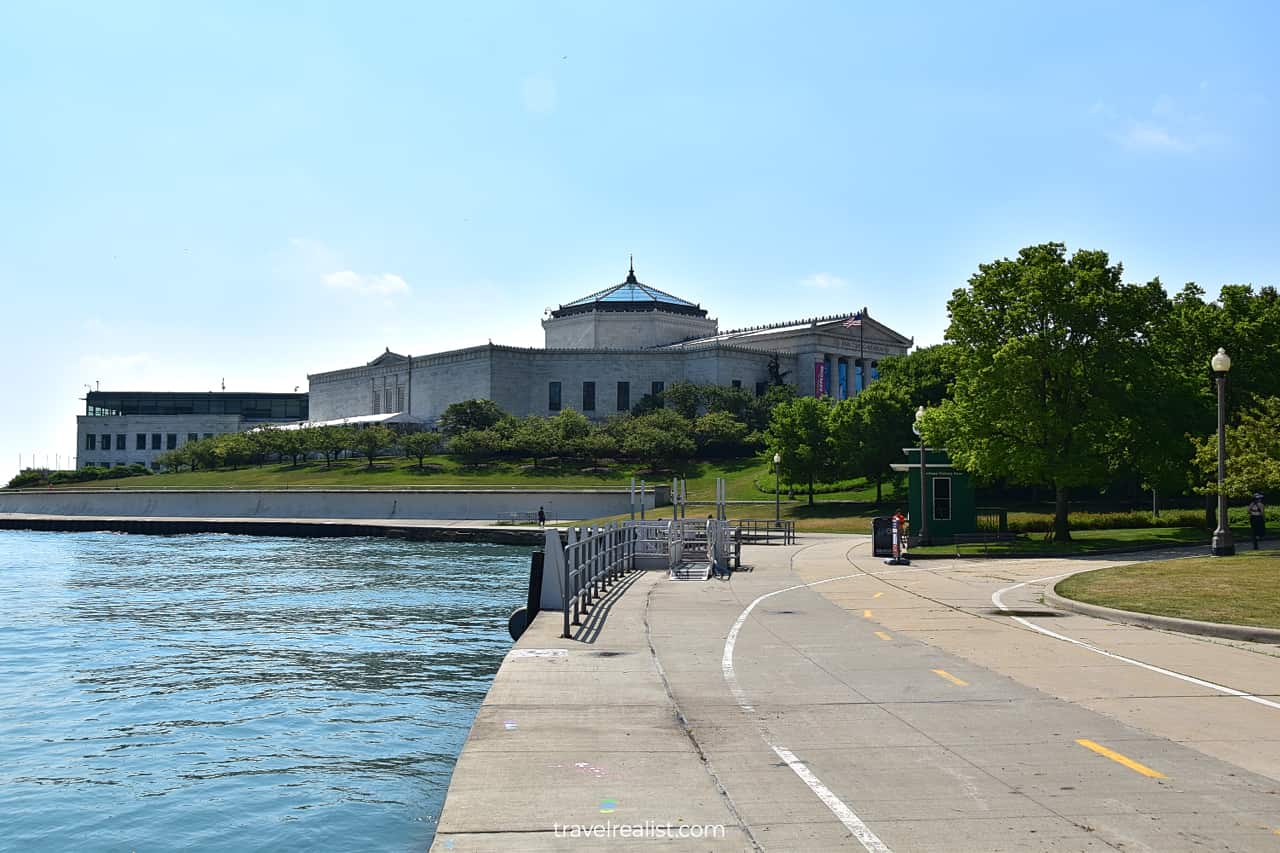
1.6. Willis Tower
The Willis Tower is the tallest skyscraper in Chicago. This black rectangular building dates back to 1973. It was known as the Sears Tower back then.
The Willis Tower was the tallest building on the planet for almost 25 years. The Petronas Towers in Kuala Lumpur, Malaysia surpassed it in 1998.
It is still the 26th tallest building in the world and the 3rd tallest building in the Western Hemisphere. Only two skyscrapers in New York City are taller than the Willis Tower in the US.
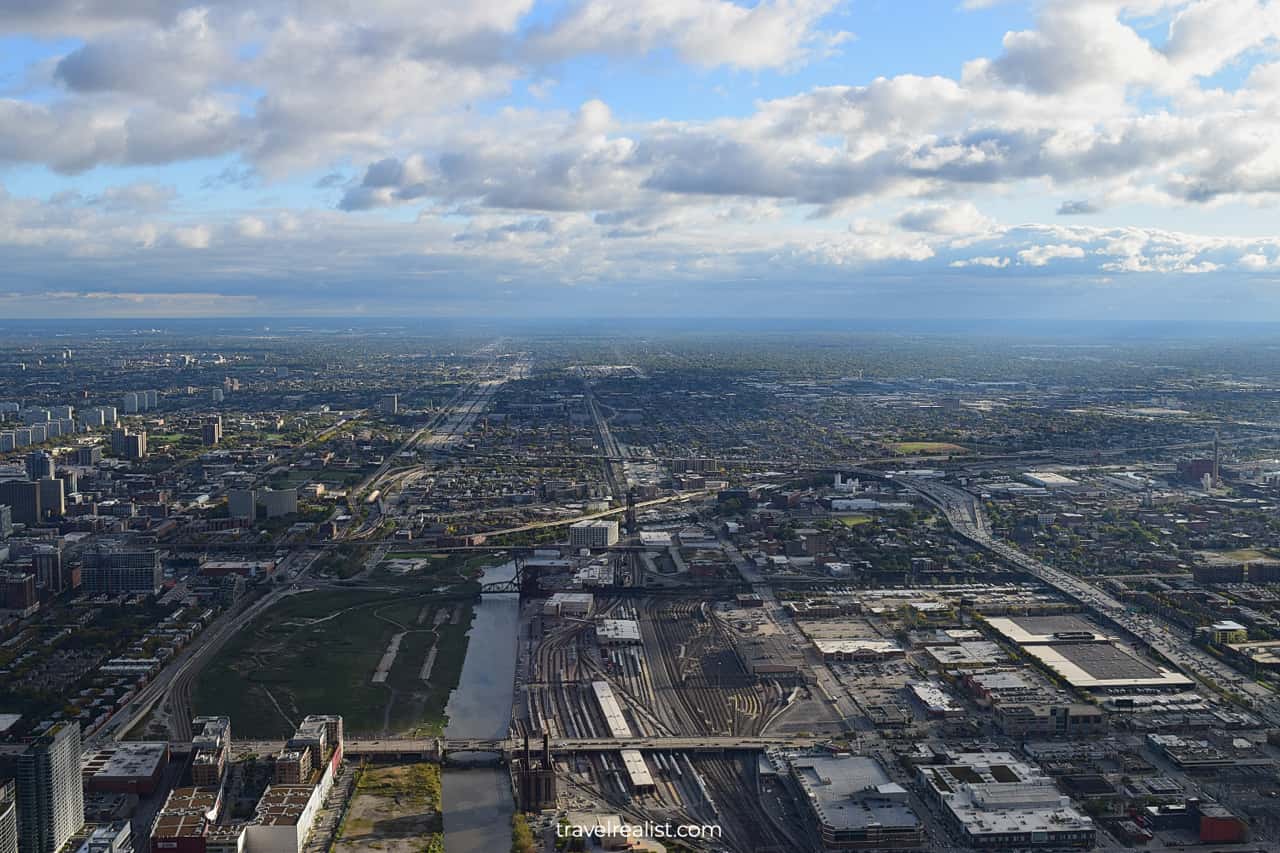
1.7. Skydeck Chicago
There is an observation deck at the Willis Tower. Skydeck Chicago at Willis Tower is 1,353 ft (412 m) above the ground. About 1.7 million people visit it every year.
The Skydeck is open between 9 a.m. and 10 p.m. every day of the week from March to September. The observation deck closes at 8 p.m. on weekdays in the winter.
General admission costs $46 per adult and $37 per child. Kids 3 and younger visit for free. A ticket allows you to enter the observation deck at a set time slot. Timed admission helps manage the crowds.
But you should still expect to wait in line. It happens at all observation decks. Even the CN Tower in Toronto, Canada, the highest deck in the Western Hemisphere, is not immune.
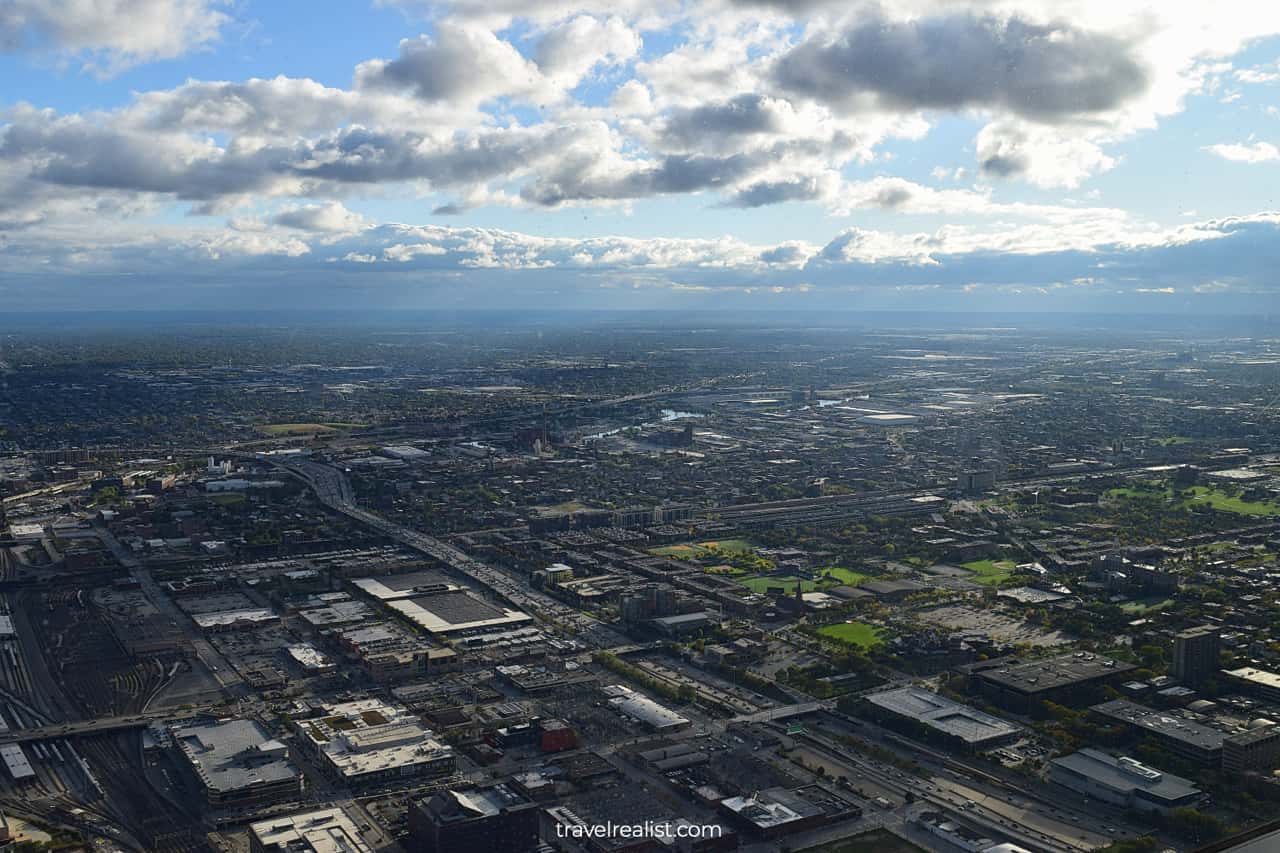
The areas west and south of the tower have industrial views. But Skydeck has an attraction on its western side. The Ledge is a glass deck that extends from the outer wall of the building.
You could step on that glass deck. Only a thick glass panel will be between you and the ground. There is nothing in-between for 103 floors.
There is a separate line to go to the Ledge. The line is long. People take their time countless pictures. If you fear heights or dislike lines, you could just skip the Ledge all together.
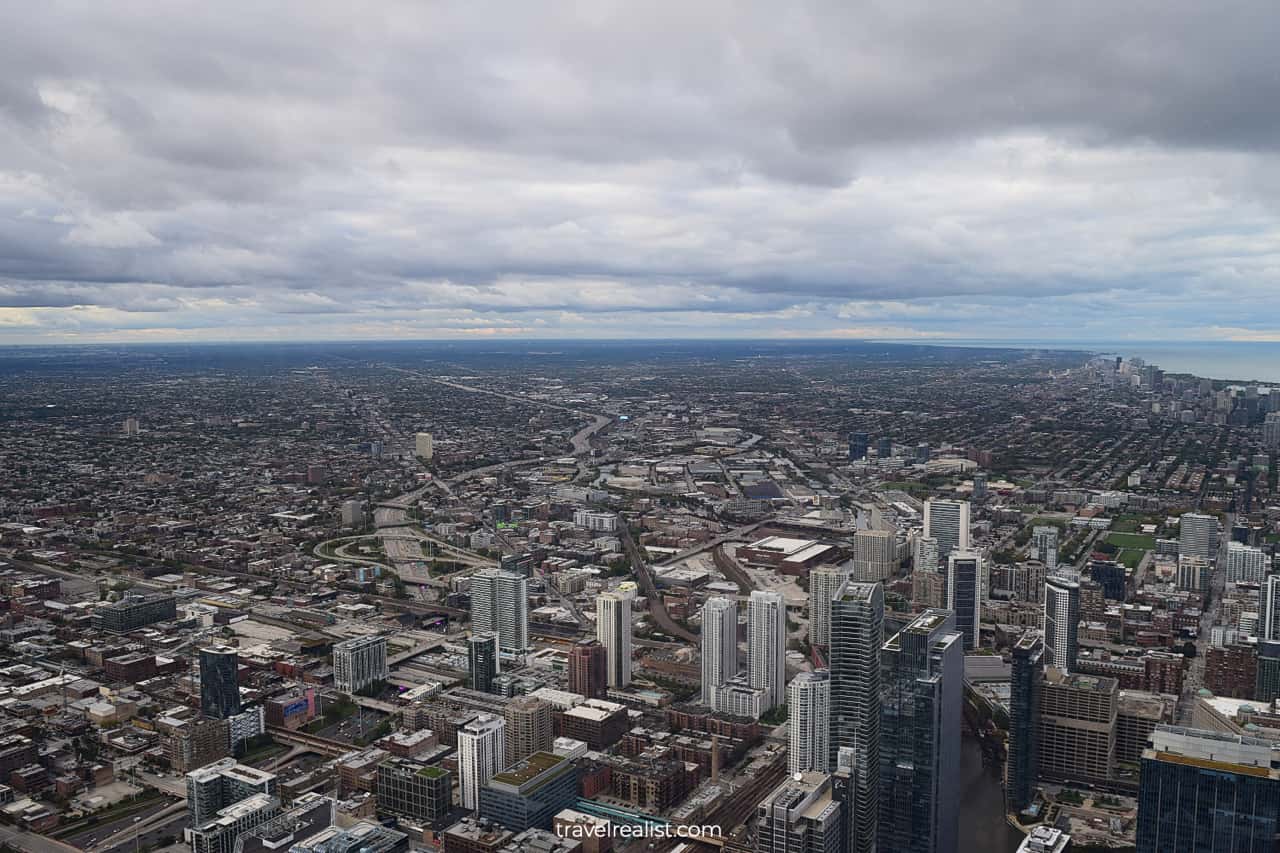
1.8. Lake Michigan
Instead, you should head to the east side of the deck. You will get amazing views of Lake Michigan, Grant Park, and Millennium Park.
You could see the Inner and Outer Breakwalls, Shedd Aquarium, and Adler Planetarium. Buckingham Fountain will also be in view, just behind 333 South Wabash, or the “Big Red”.
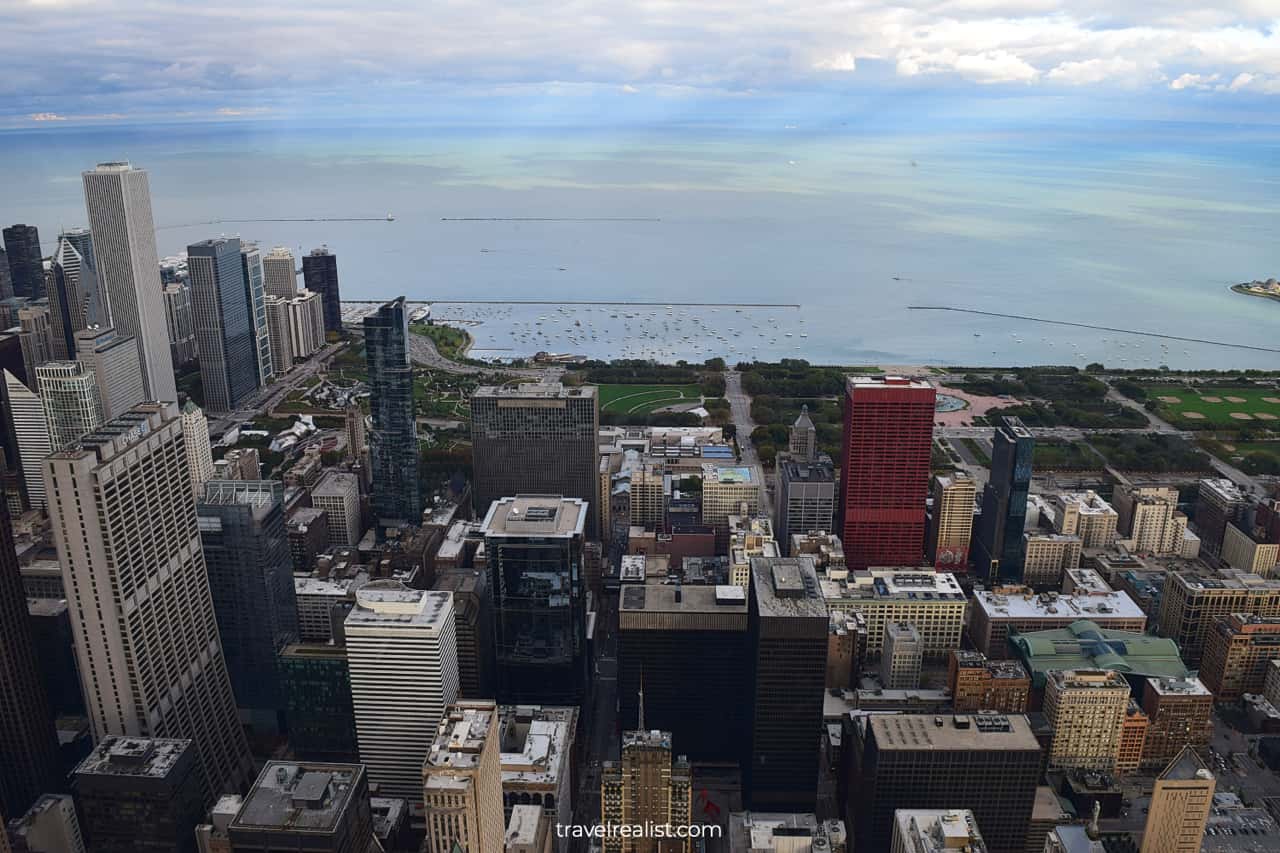
1.9. 360 Chicago
As you circle around the observation deck, you will see the buildings north of the Willis Tower. Former John Hancock Building and Trump International Hotel & Tower dominate the view.
There is another observation deck at 875 North Michigan Avenue. 360 Chicago Observation Deck is 1,030 ft (314 m) above the ground.
It gives you a way to see Chicago from above for $30 per adult and $20 per child. 360 Chicago works best if the height of the observation deck is not a dealbreaker for you.
The views from both Skydeck and 360 Chicago are quite similar in the end. Pick one that works better with your route and budget.
Your self guided Chicago Architecture Walking Tour could come to an end after visiting one of the observation decks.
There are still buildings for you to see in the city. But you might find them easier to see from a river cruise. It is the focus of the next section of this Chicago Architecture Comprehensive Guide.
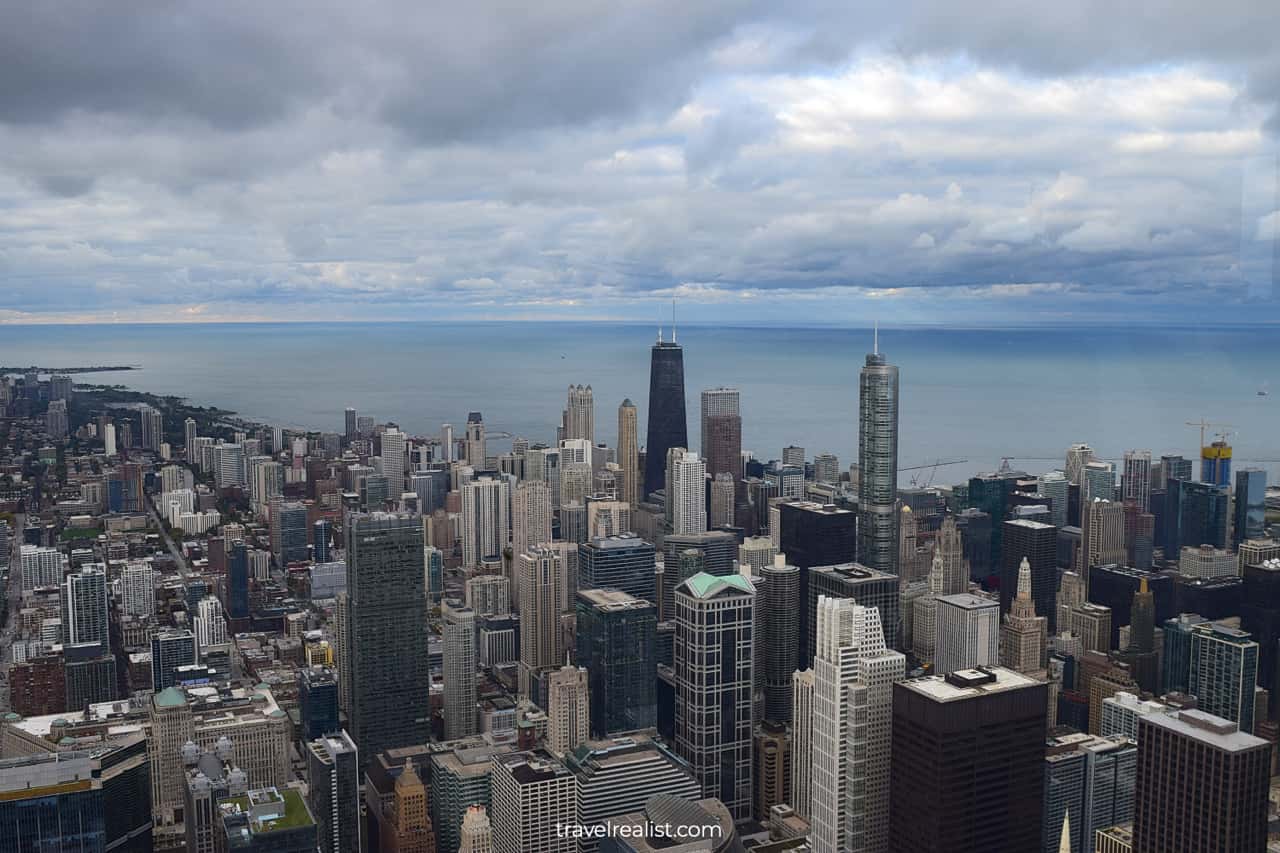
2. Chicago Architecture River Cruise
A river cruise is a great way to see the buildings in “The Windy City”. As a matter of fact, it is one of the most popular ways to see the city.
There are a handful of companies that offer Chicago Architecture River Cruises. They have different boats, cruise duration, schedule, route, and pricing. Here are the main operators with prices:
- Wendella: a 90-minute cruise from Michigan Avenue; $42 per adult
- Chicago’s First Lady: a 90-minute cruise from Michigan Avenue; $53.85 per adult
- Shoreline Sightseeing: a 75-minute cruise from Michigan Avenue or Navy Pier; $49 per adult
- CityExperiences: a 75-minute cruise from Navy Pier; $40+ per adult
- Tours and Boats: a 90-minute cruise from South Loop; $49 per adult
- Chicago Line Cruises: a 90-minute cruise from Ogden Slip near Navy Pier; $50 per adult
- Chicago River Boat Architecture Tours: a 90-minute cruise from Ogden Slip near Navy Pier; $49 per adult
This Chicago Architecture Comprehensive Guide discusses a typical path of a Chicago River cruise.
2.1. DuSable Bridge
A few Chicago Architecture River Cruises start on either side of the DuSable Bridge. This bridge connects the Loop with the Near North Side via Michigan Avenue.
In fact, it used to be called the Michigan Avenue Bridge from 1920 to 2010. But a change in name is not the only thing special about this bridge.
This drawbridge has two levels. Each level has traffic lanes and pedestrian walkways. The upper level has statues and ironwork. The flags of the United States, Illinois, and Chicago round up the bridge exhibits.
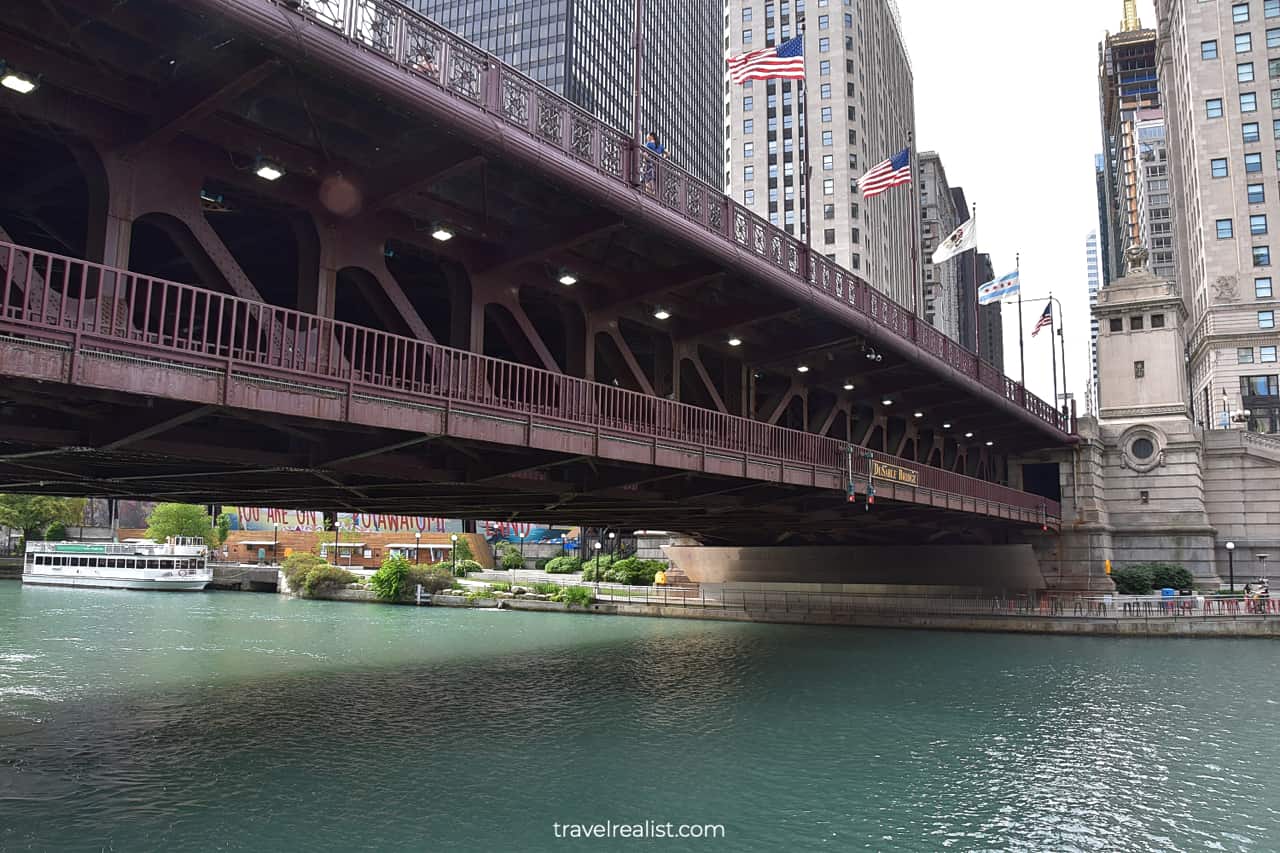
2.2. London Guarantee Building
You could start enjoying Chicago Architecture while waiting for your river cruise to board. The London Guarantee Building is visible from the waiting area.
This 1923 building is a historic skyscraper on the south bank of the Chicago River near the DuSable Bridge. You can easily recognize the London Guarantee Building thanks to a rotunda.
The building has been home to LondonHouse Chicago, Curio Collection by Hilton since 2016. It is a great place to stay if you enjoy historic buildings.
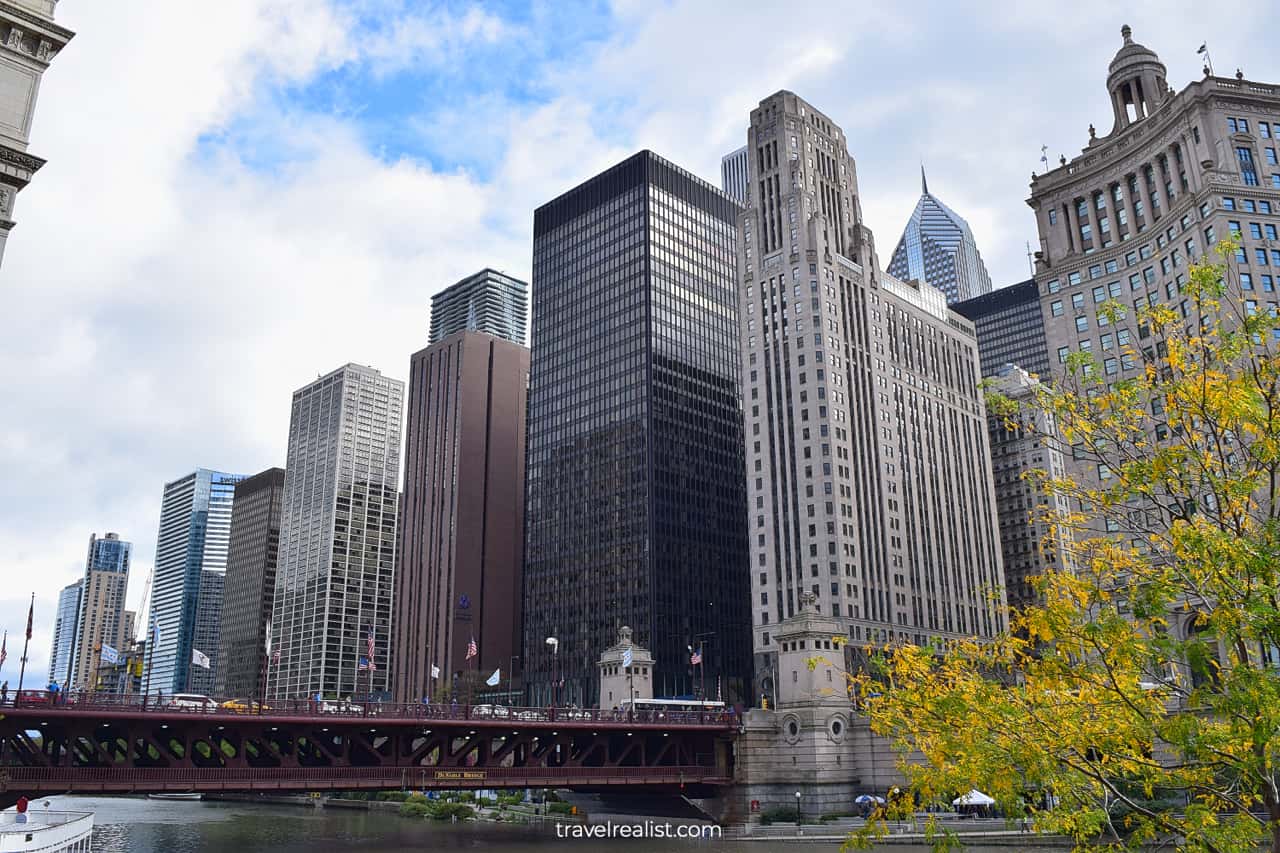
2.3. Jewelers Building
The Jewelers Building is the next historic structure to see on a Chicago Architecture River cruise. This building carried a number of names over the years. You could find it under 35 East Waker now.
The Jewelers Building dates back to 1927. It has 40 stories and reaches a height of 523 ft (159 m). It is very easy to recognize this building. There is a dome at its top and four turrets.
The easy-to-recognize outline of this building has become part of the popular culture. 35 East Waker has been in a handful of movies, TV series, video games, and even city tales.
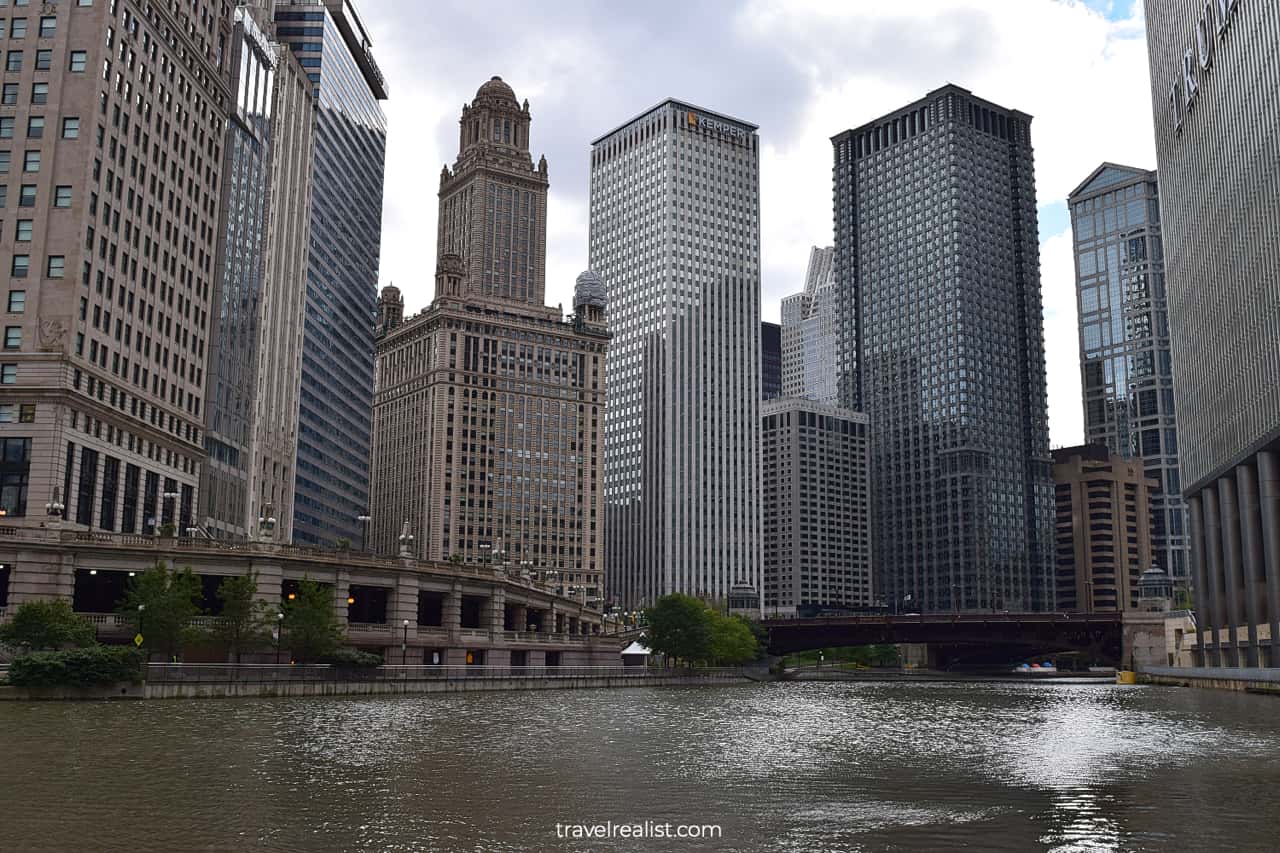
2.4. Clark Street Bridge
Your Chicago Architecture River cruise will first go west. You will pass three bridges on the way to Clark Street.
The Irv Kupcinet Bridge, the Bataan-Corregidor Memorial Bridge, and the Dearborn Street Bridge are all drawbridges. They share a similar metal and stone design.
In fact, you might find it difficult to find any differences between them. Only the name plaques on the bridges tell what street you are about to cross.
The same description applies to the Clark Street Bridge. It dates back to 1929. Yet, there has been a bridge at Clark Street since 1853.
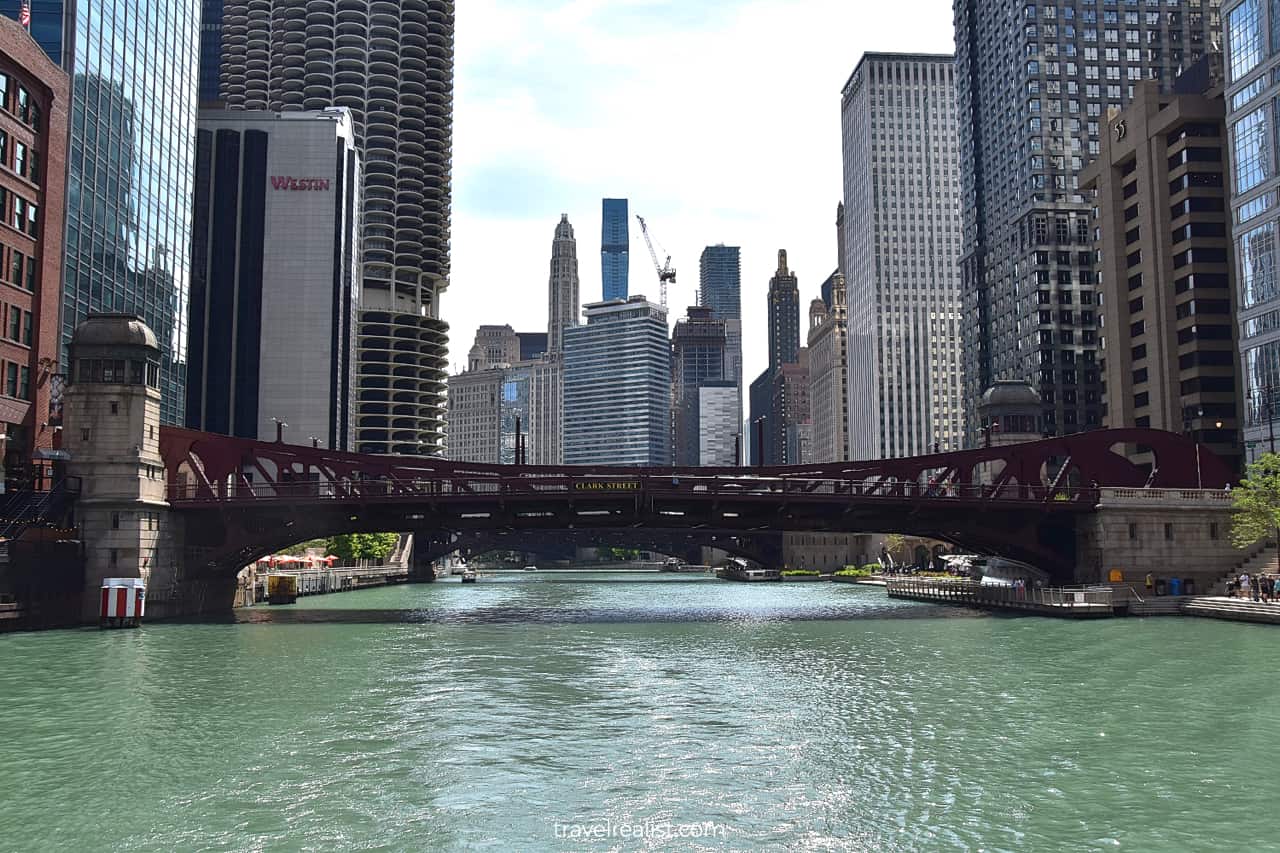
2.5. Reid, Murdoch & Co. Building
As soon as your boat passes the Clark Street Bridge, you should look to the north bank. The Reid, Murdoch & Co. Building will be on your right.
This 7-story landmark was built in 1914 as a warehouse. It became an office building in the mid 20th century. The City of Chicago and a few private businesses have been its tenants during these years.
The Reid Murdoch Building is one of the most recognizable structures on the cruise. Just look for a red brick clocktower. The current tenant of the building will likely display their logo just above the clock.
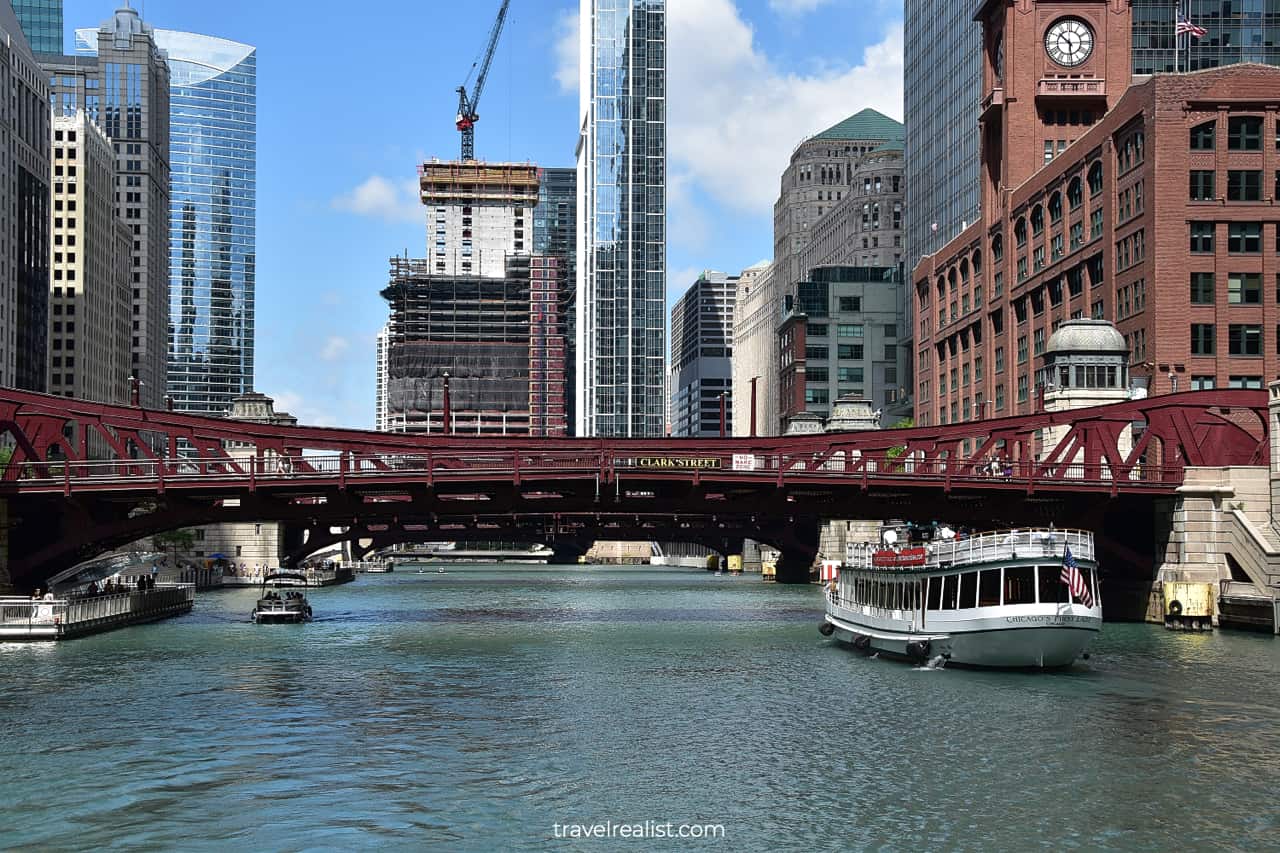
2.6. Merchandise Mart
The cruise will then pass two more bascule bridges. The Marshall Suloway Bridge and the Wells Street Bridge look a lot like other bridges over the Chicago River.
You should continue paying most of your attention to the north bank of the river. You will soon see the Merchandise Mart.
This massive Art Deco building dates back to 1930. It used to be the largest building in the world back in the day. USPS even assigned the Merchandise Mart its own zip code.
The nearby towers make it more challenging to understand how large this building really is. But you would still feel quite small even if you are just passing by.
The facade of the Merchandise Mart is the world largest digital art projection. You could see art on this building if you visit it after the sunset.
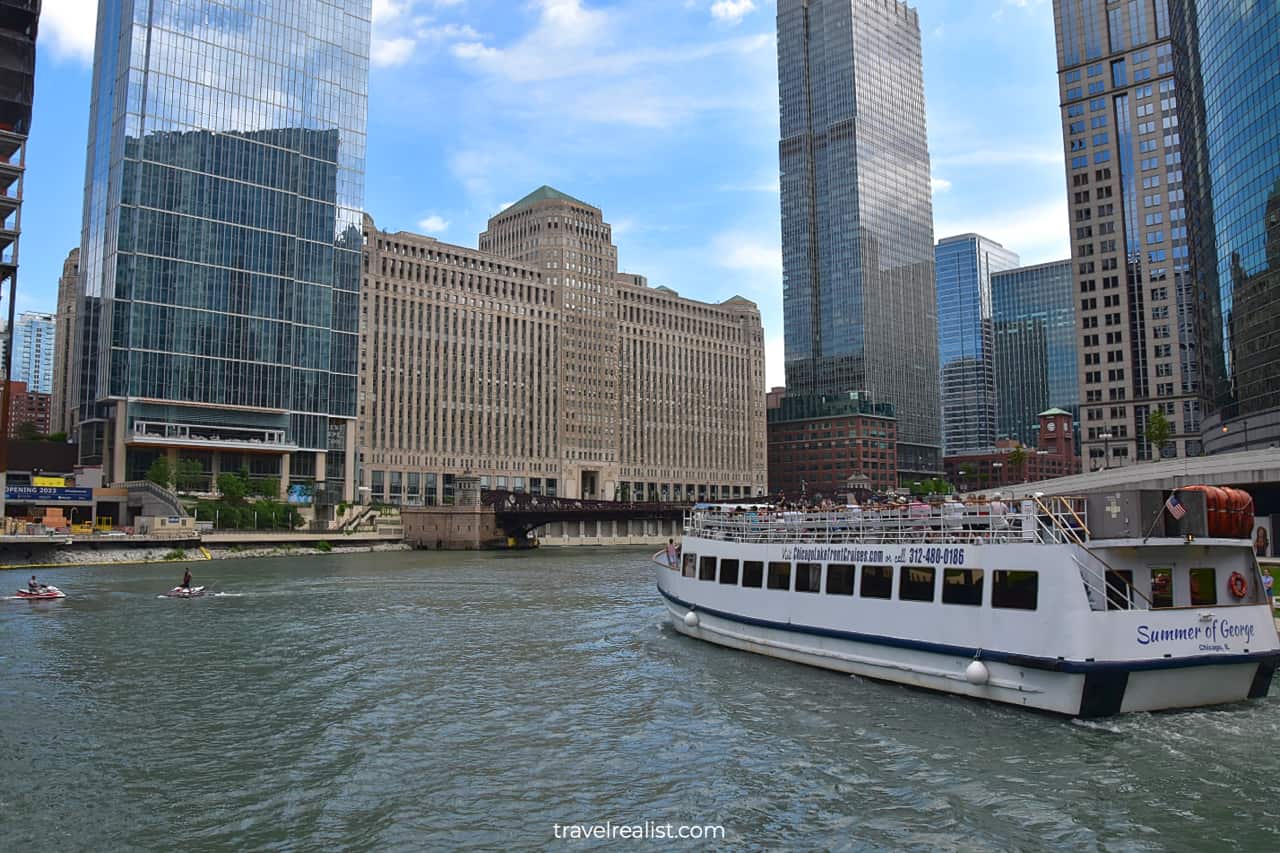
2.7. Kinzie Street Railroad Bridge
The Merchandise Mart is at the junction of the two Chicago River branches. The North Branch starts right before the Kinzie Street Railroad Bridge.
The bridge dates back to 1907. It provided a railway connection to the plants east of the Chicago River. But the railroad demand went down as the Near North Side neighborhood became more residential.
This bridge is a Chicago landmark. While it remains active, you will see it in a raised position during most of the year.
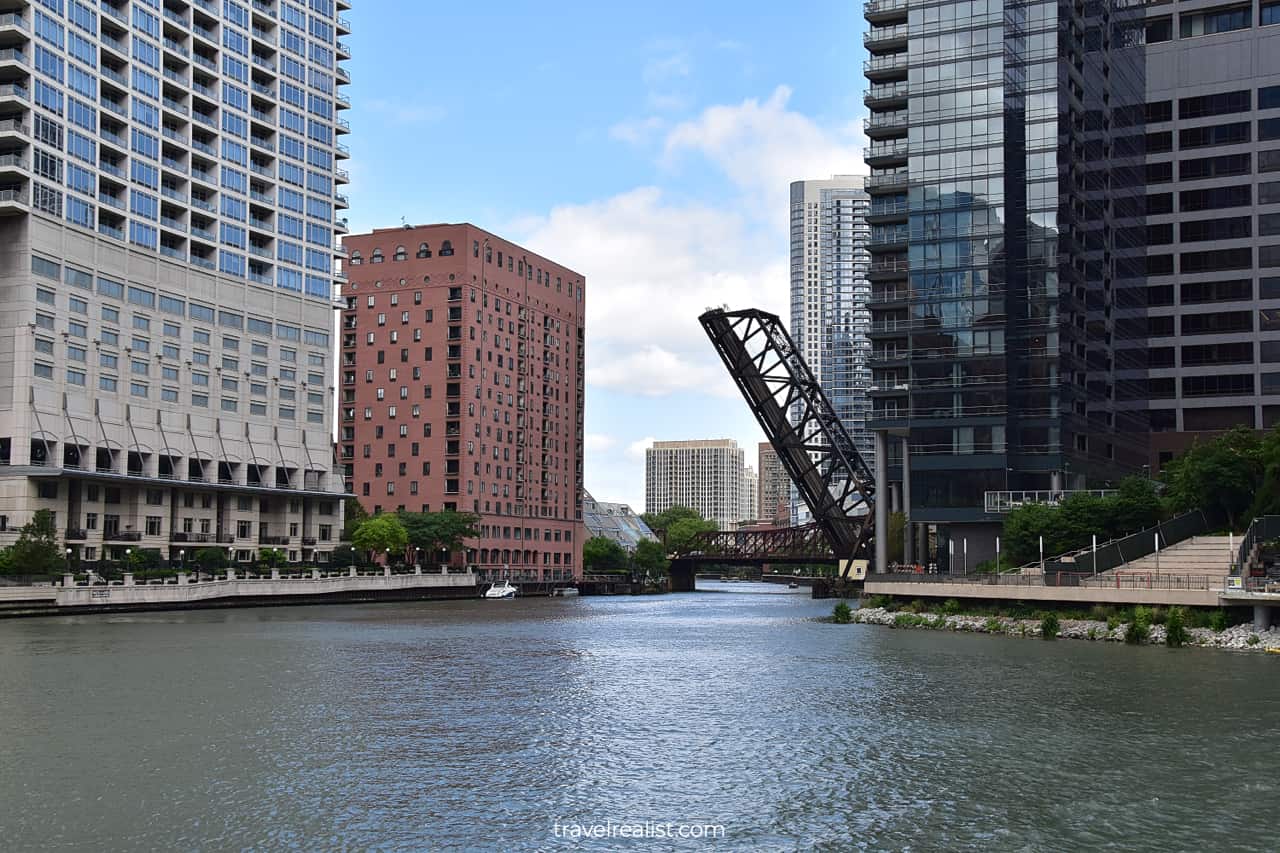
2.8. Constellation Sculpture
A few Chicago Architecture River Cruises take the North Branch. But most go south towards Lake Street. This part of the Loop has a few more notable structures.
Constellation sculpture by Santiago Calatrava Valls is the first of them. It is a fairly new addition to the city. The red sculpture was installed in 2020.
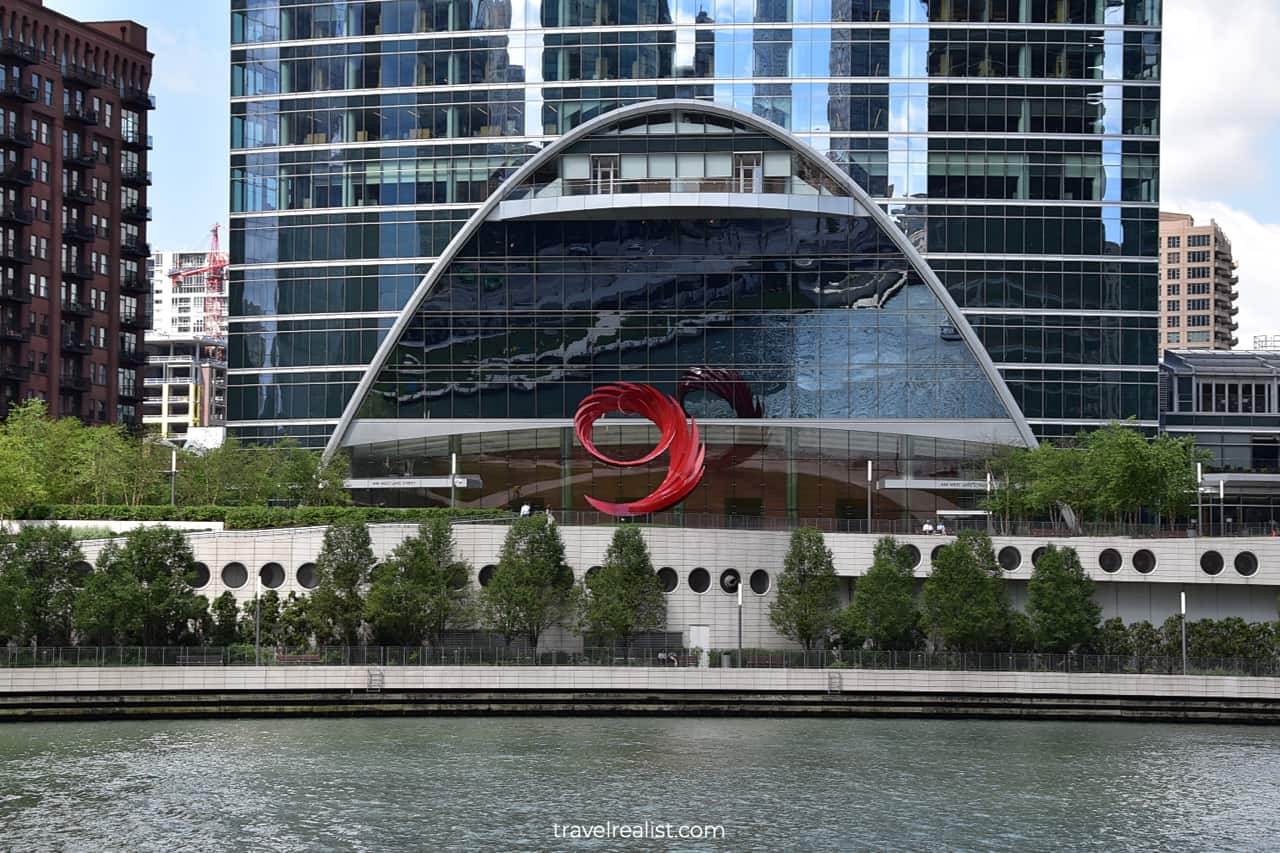
2.9. Civic Opera House
The Civic Opera Building is the next fascinating structure you will see on the cruise. This building takes up the entire block between Washington Street and Madison Street.
It is another massive structure. Not unlike the Merchandise Mart and the Willis Tower, the Civic Opera Building has a record of its own. It is home to the second largest opera house in North America.
You could catch a performance at Lyric Opera of Chicago after your river cruise ends. It is a great opportunity to see the Art Deco interior of the nearly 100-year old building.
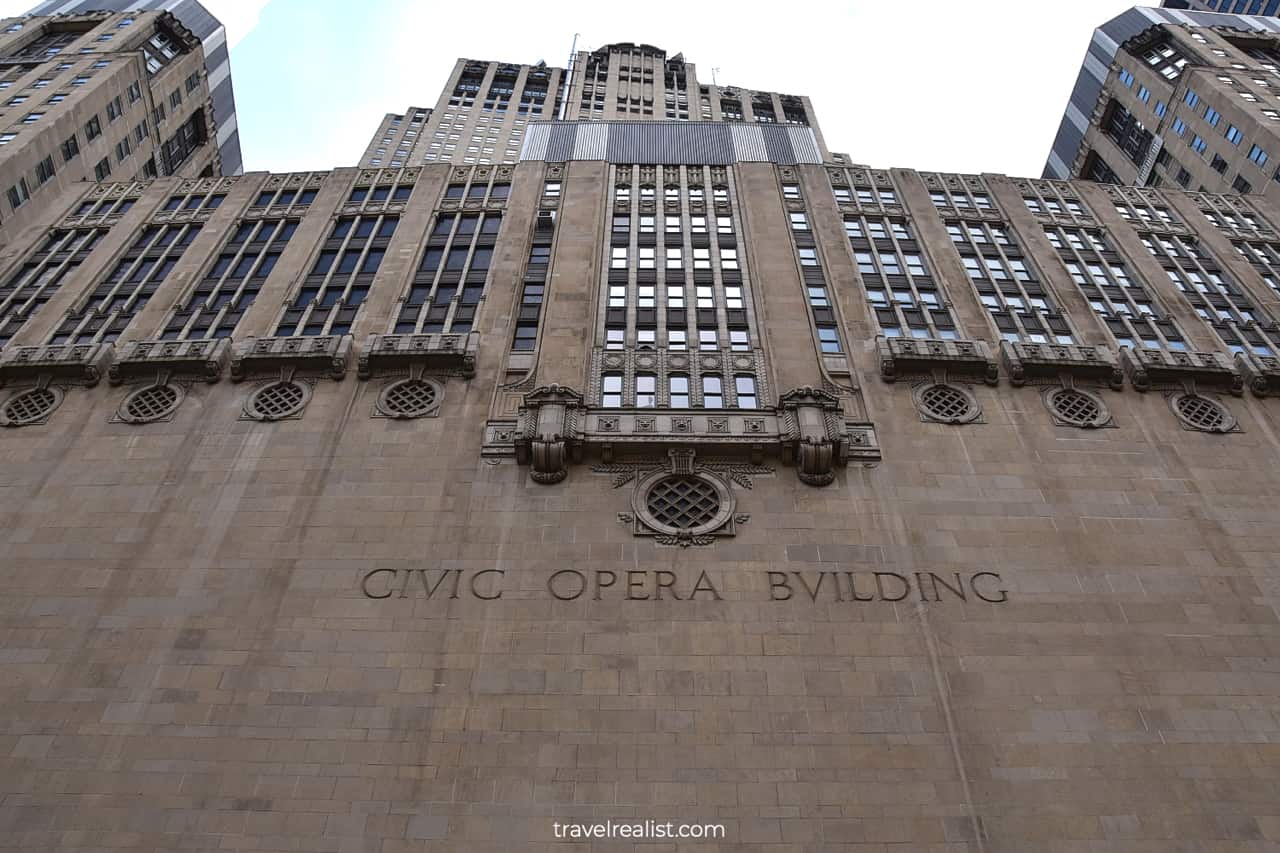
2.10. Willis Tower
Almost every Chicago Architecture River Cruise brings you to the western side of the Willis Tower. The tallest building of the city is a necessary stop on an architecture cruise.
You will be less than a block from the Willis Tower. But this proximity creates challenges when you account for the height of the building.
You might find it difficult to see the entire tower. The lower sections of the Willis Tower will be hidden by other buildings on the river bank.
But you should get a good look at its upper section. You might be even able to see the Ledge at the Skydeck Chicago observation deck from the boat.
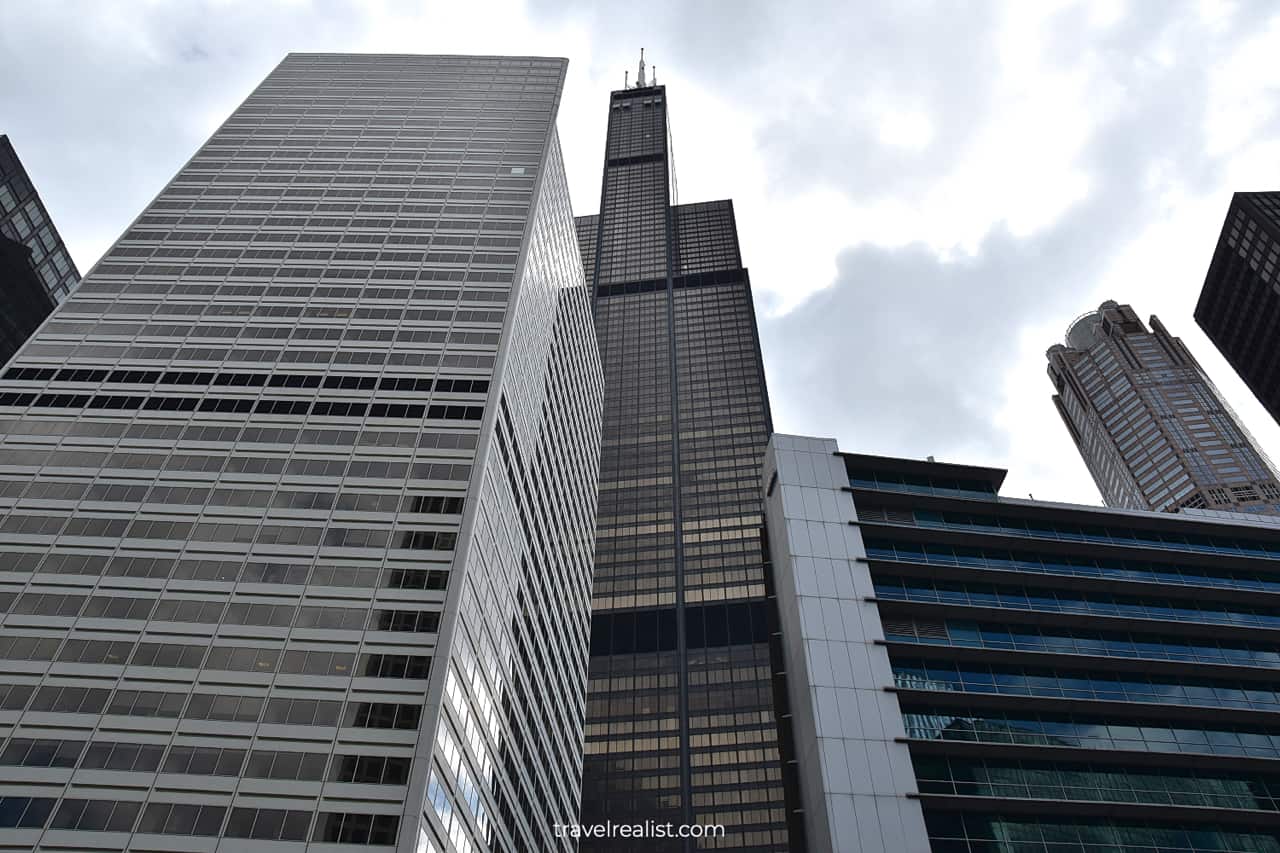
2.11. Monroe Street Bridge
The Monroe Street Bridge marks a turning point for nearly all Chicago Architecture River Cruises. The structures become slightly less stunning a few blocks south from this bridge.
You will enter see more residential and industrial buildings after the Congress Parkway Dwight Eisenhower Bridge. There are fewer high-rise buildings on either side of the river.
As a result, turning back is a sensible decision. You will have another opportunity to admire the Civic Opera Building, the Mart, and the Reid Murdoch Building.
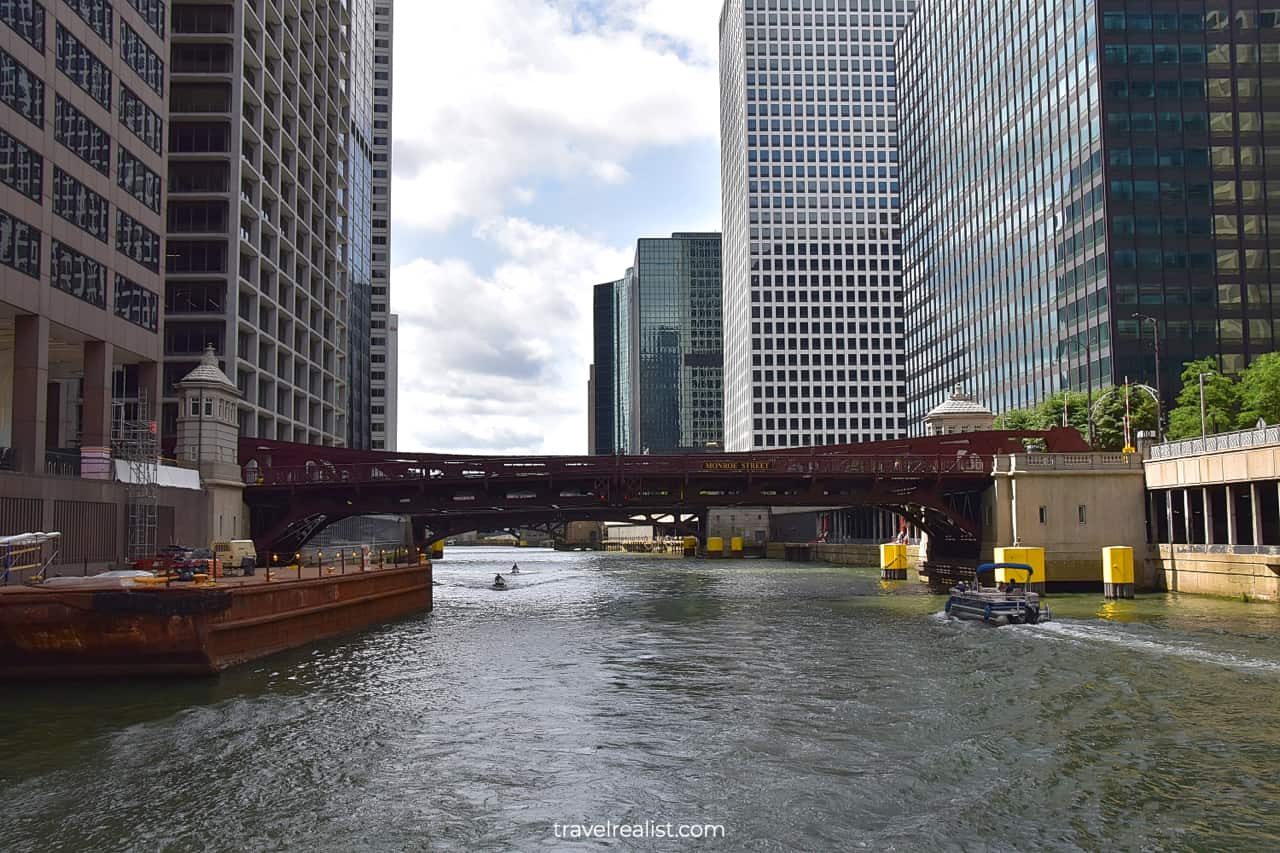
2.12. Wrigley Building
But you should not worry about your cruise ending yet. There are still a couple of buildings to see near the DuSable Bridge and Michigan Avenue.
The Wrigley Building is one of them. This landmark skyscraper was built in 1924. The building has two towers of different heights. You will have a better look at the South Tower.
This tower is not only closer to the Chicago River, but it is also 9 floors higher. The South Tower rises 425 ft (130 m) and has 30 floors. The 21st floor is the top floor at the North Tower.
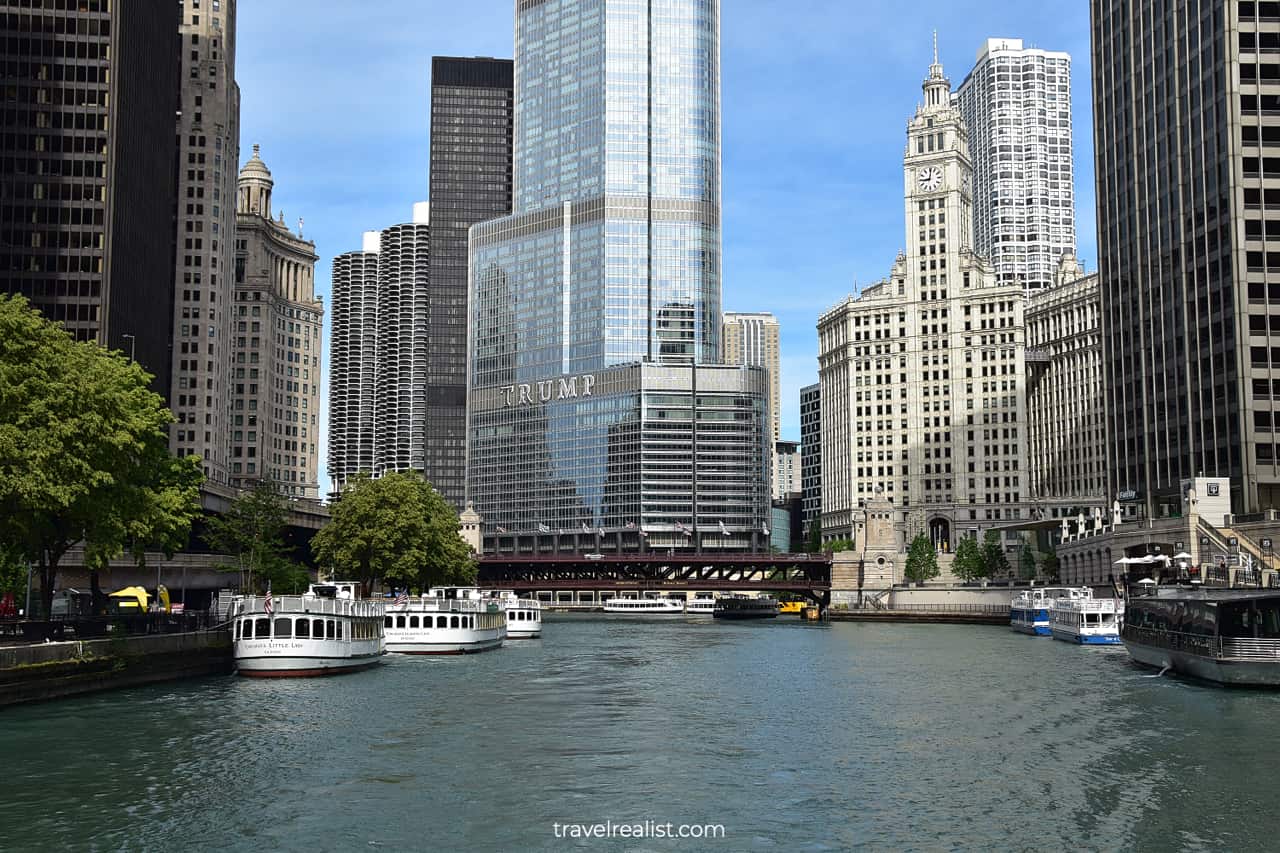
2.13. Tribune Tower
The Tribune Tower will likely be the last building you see on a Chicago Architecture River Cruise. This skyscraper was built around the same time as the Wrigley Building.
While both towers date back to the same period, they could not be more different. The Tribune Tower is a neo-Gothic skyscraper.
It resembles the Gothic cathedrals in France more than other buildings in the Midwest. The Tribune Tower has 6 more floors than the Wrigley Building. The tower is 463 ft (141 m) tall.
The name of the Tribune Tower refers to its previous tenant. The tower was home to the Chicago Tribune, a daily newspaper founded in 1847.
The newspaper organized a competition to pick a design for its new headquarters. The winning design still amazes locals and visitors some 100 years after its completion.
This building is the last one on the cruise. Unless your river cruise started at Navy Pier, you will be returning to a dock near the DuSable Bridge.
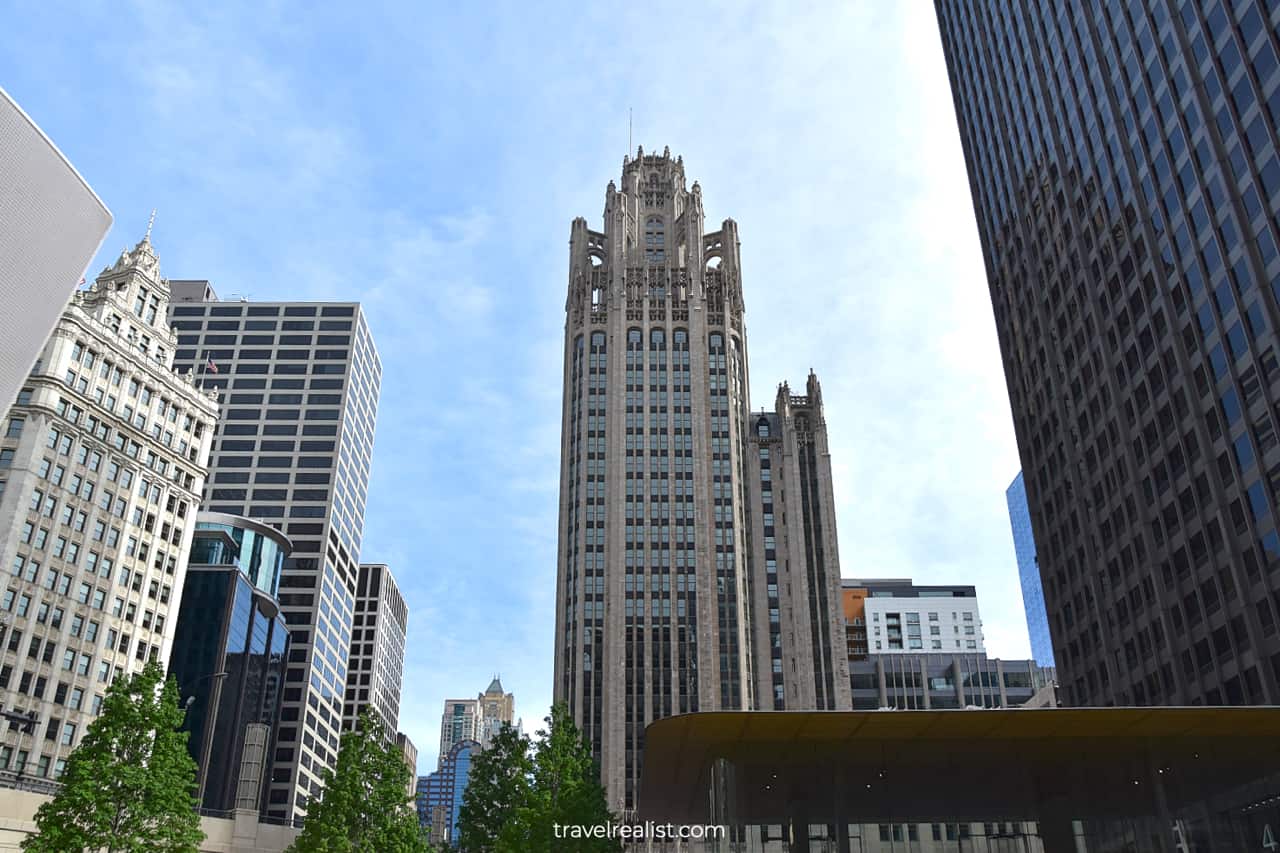
3. Lake Michigan Architecture Cruise
Chicago Architecture River Cruises have been an iconic city experience for nearly 100 years. A handful of operators also started offering Lake Michigan tours.
As their name suggest, these tours bring you to the lake. They take you further away from the city skyscrapers and historic buildings. This is a different way to admire the city architecture.
Navy Pier is the starting point for most lake only cruises. Lake Michigan could experience storms and high waves. Starting at Navy Pier allows companies to use bigger boats.
Some operators combine the river and lake into a single cruise. Most of these tours start at a terminal near Michigan Avenue, just like the river cruises.
A River & Lake Architecture Cruise costs at least $40 per adult. The child tickets are usually about half of the adult price.
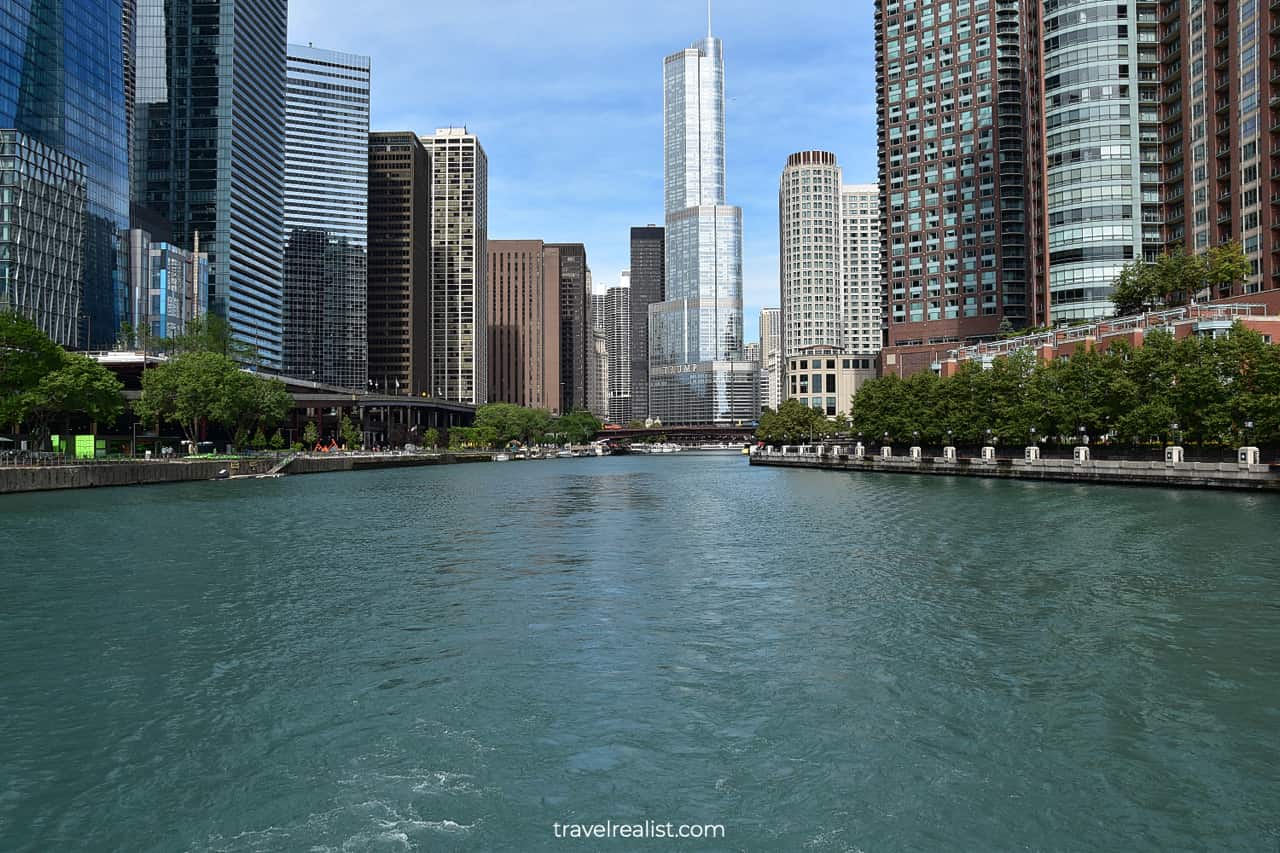
3.1. Chicago Harbor Lock
This Chicago Architecture Comprehensive Guide follows a Lake Michigan cruise from the Michigan Avenue. These tours first need to go to the mouth of the Chicago River and pass through a lock.
The Chicago Harbor Lock is part of the system that reversed the flow of the river to deal with pollution. Instead of flowing into Lake Michigan, the Chicago River flows to the Mississippi River.
A handful of locks, like the Chicago Harbor Lock, made this reversal possible. It is a fascinating process to see the locks at work. This is one of the reasons to take the Lake Michigan Architecture Cruise.
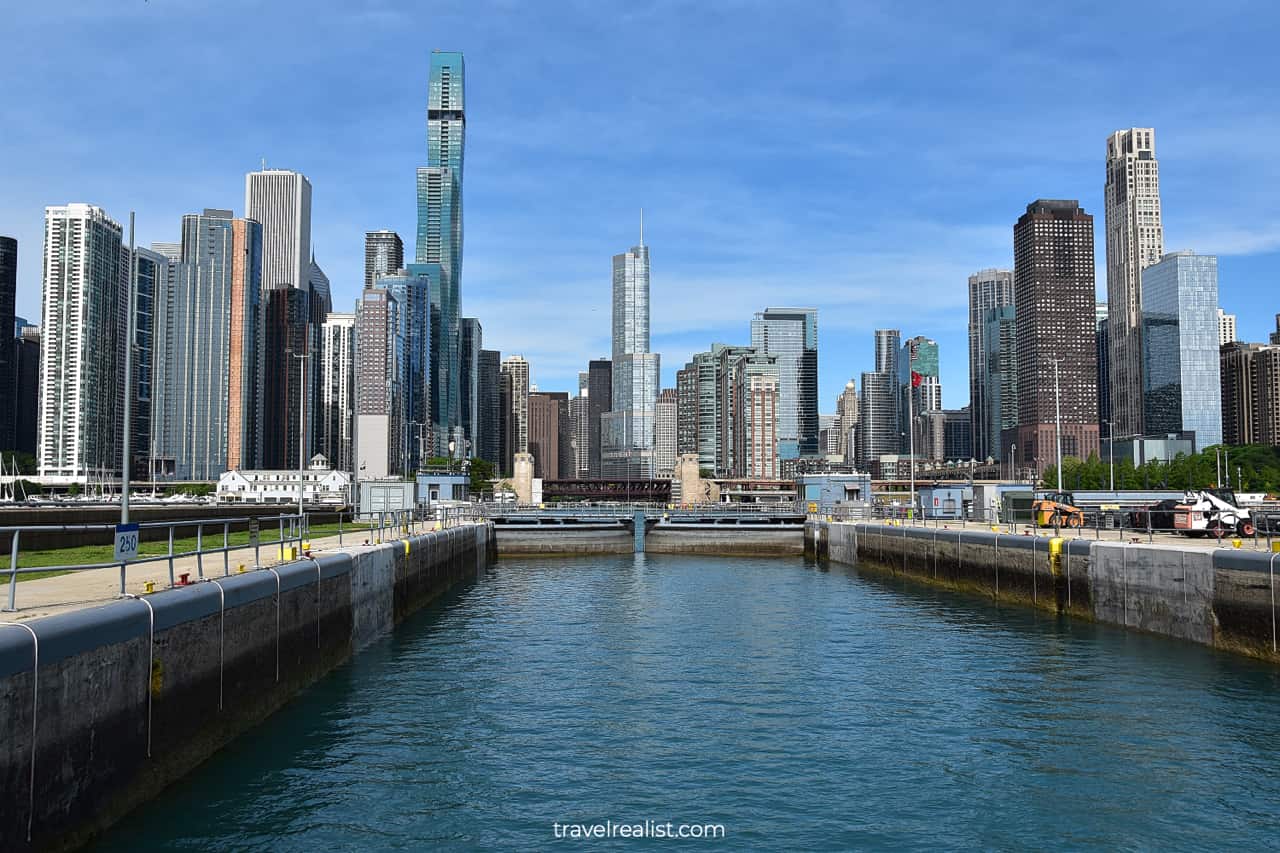
The lock takes about 15 minutes to even out the differences in water levels between the lake and the river. But it could easily take more time, particularly on the tours later in the day.
The Chicago Harbor Lock is a bottleneck. There is enough space for only a couple of boats in the lock. A part of the cruise will involve you waiting in a boat traffic jam.
You could enjoy the views of yachts on Lake Michigan while you wait. Distant views of Trump International Hotel and Tower and St. Regis Chicago could also help kill time.
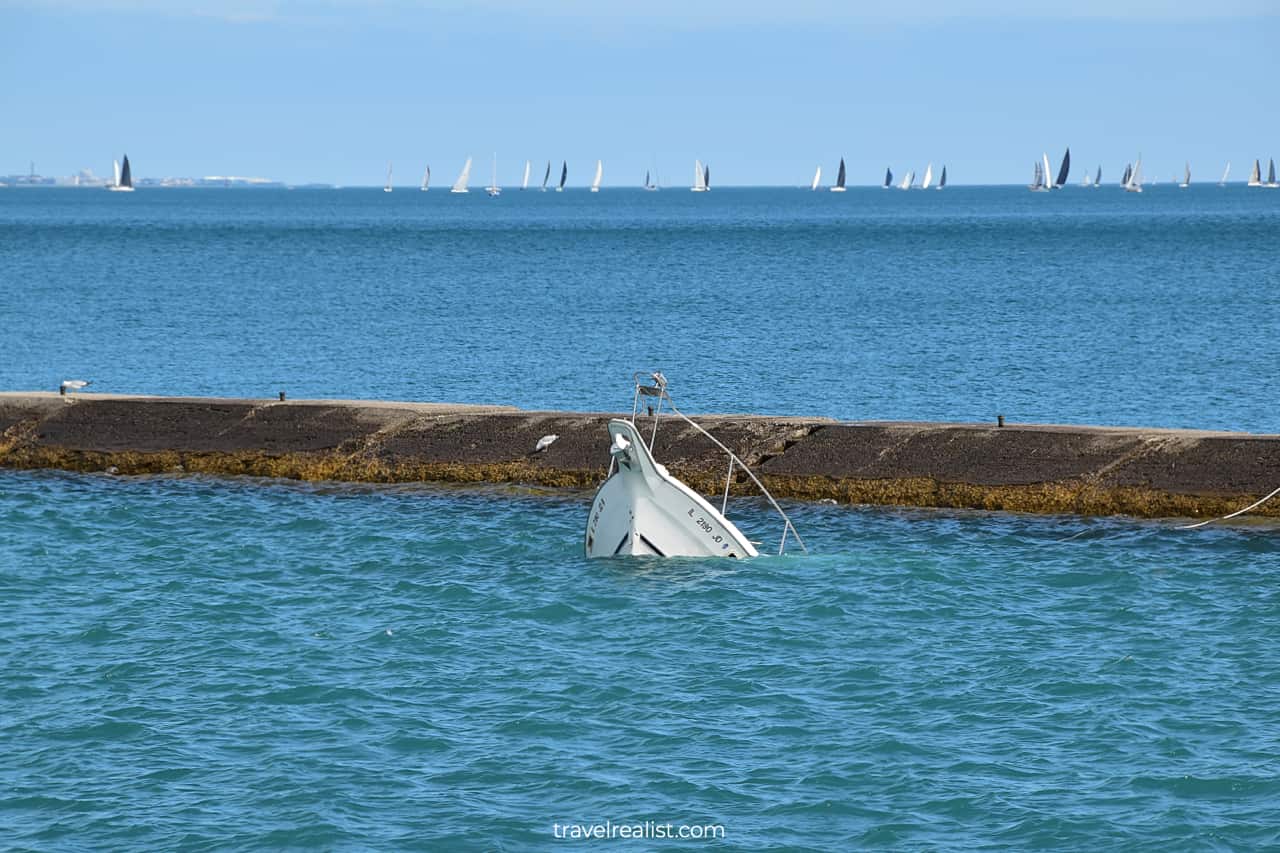
3.2. Navy Pier
The Lake Michigan Architecture Cruise goes away from the shore after clearing the lock. If you look north, you will see Navy Pier and the former John Hancock Building.
Navy Pier is an iconic city destination that dates back to 1916. The Pier has restaurants, shops, parks, and attractions. It is home to Centennial Wheel, Children’s Museum, and Chicago Shakespeare Theater.
There is even a hotel on Navy Pier. You are welcome to stay at Sable at Navy Pier Chicago, Curio Collection by Hilton. In this case, you could start your tour right from the doorstep of your hotel.
Local and visitors come to Navy Pier for the 4th of July and New Year fireworks. Some 9 million people visit Navy Pier. It could rival 15 million that visit Pier 39 in San Francisco, California every year.
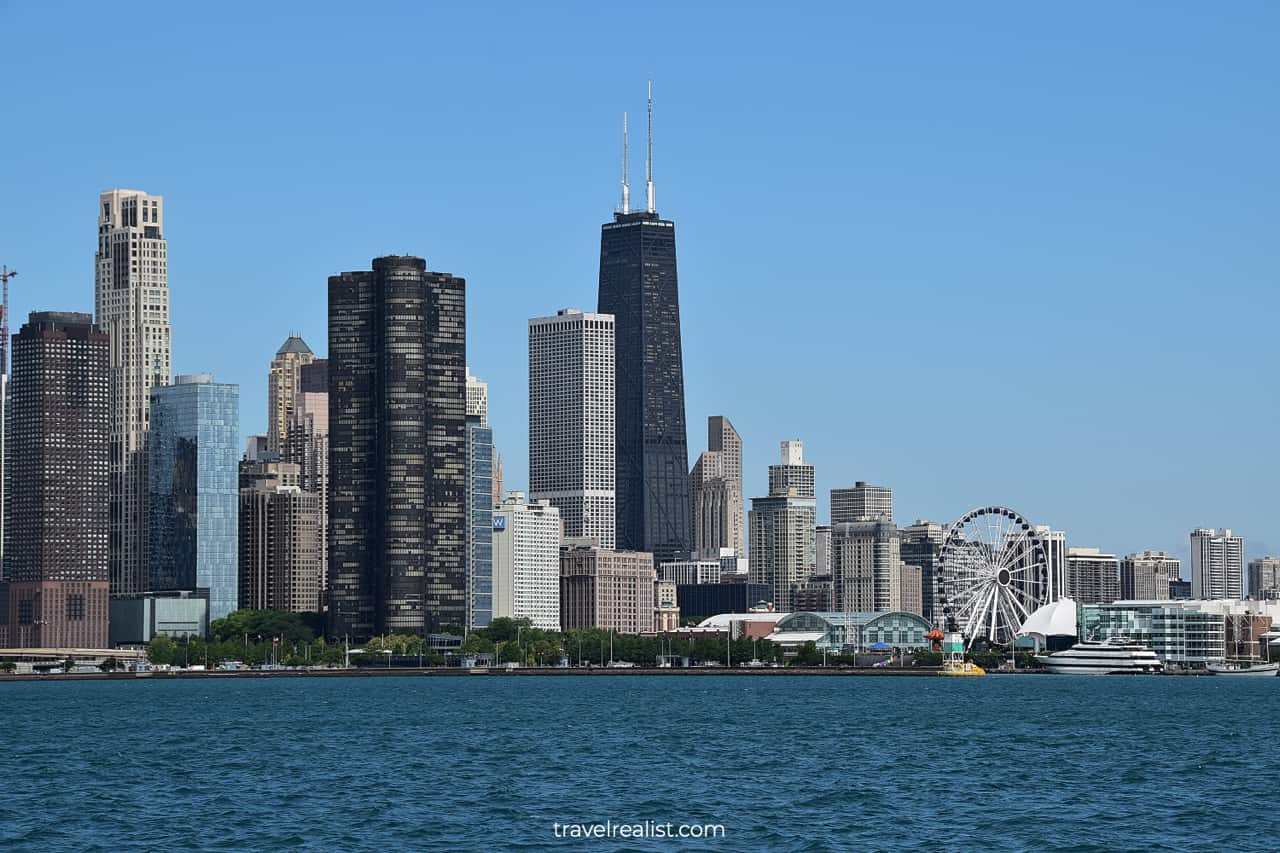
3.3. Navy Pier Auditorium
Most Lake Michigan Architecture Cruises follow the same route. They continue east in the Chicago Harbor until they reach the end of Navy Pier.
The tour boat then turns north and goes around the Pier. You will have a front row seat to the Navy Pier Auditorium, or the Hall. This beautiful festival hall was built with the original pier in 1916.
The Hall has capacity for 1,400 people. It has housed countless music performances, conferences, and other events over the years.
Look closer at the row of US, Illinois, and Chicago flags. There is an anchor and a statue. The Chicago warship anchor is a memorial. The statue commemorates Bob Newhart, an actor and an Oak Park native.
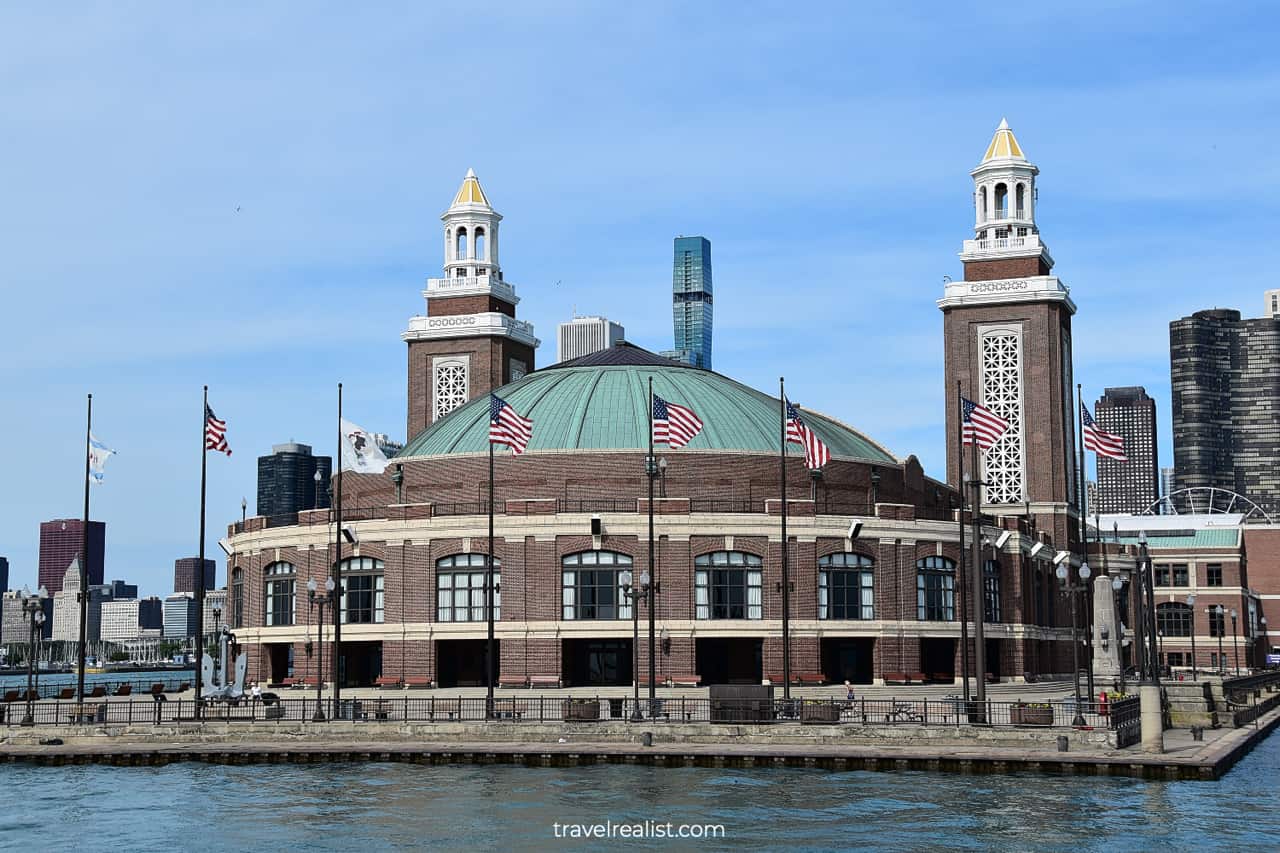
3.4. Jardine Water Purification Plant
You will see lots of trees as soon as the cruise boat circles around Navy Pier. You might think that it is a park that you should visit later. But you would be partially wrong.
The trees disguise Jardine Water Purification Plant, the largest such plant in the world. Yet, there is a small park behind it. Milton Lee Olive Park has nice views of the buildings in the Near North Side.
Chicago has long struggled with pollution. It went hand in hand with its industrial development. High pollution levels even led to the reversal of the Chicago River.
The city has made a lot of efforts to improve the quality of its drinking water. This water purification plant is part of a larger water supply system.
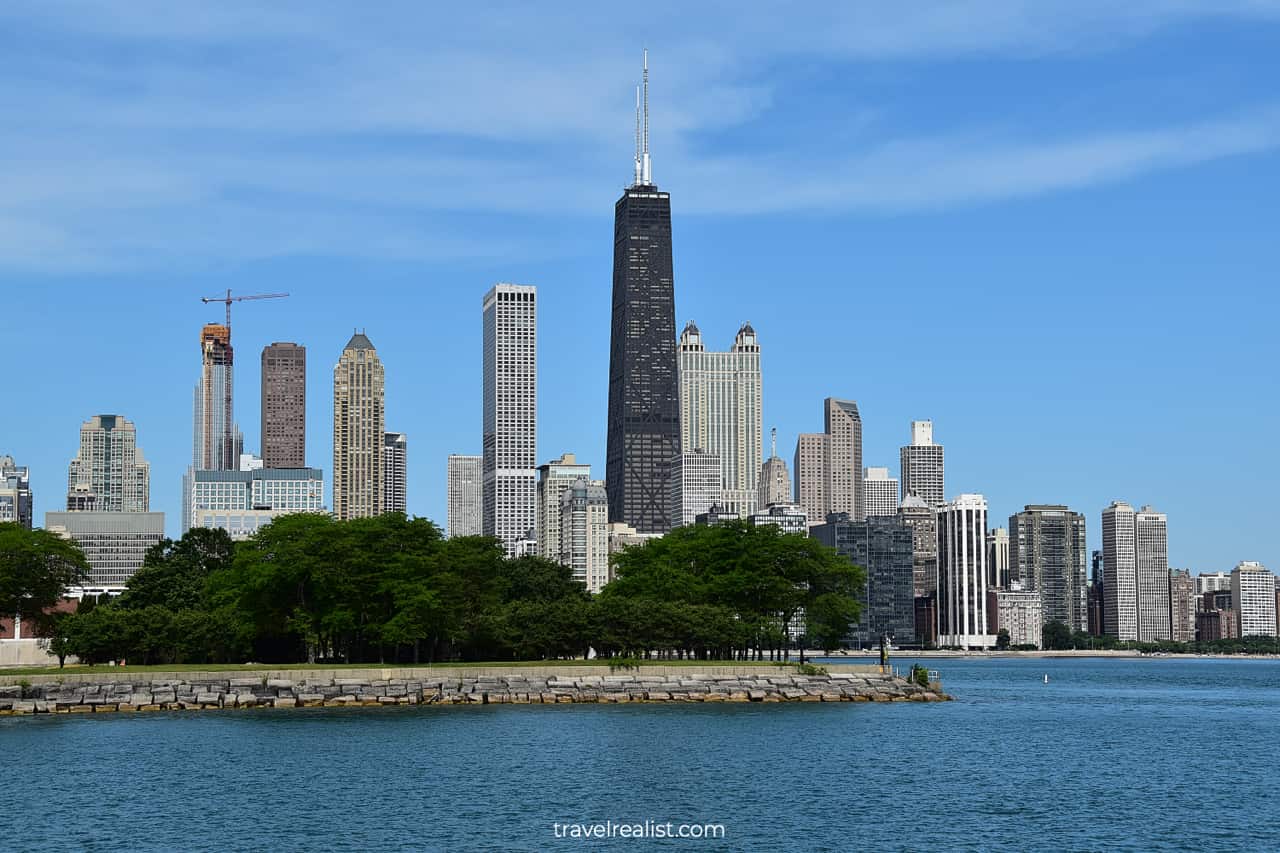
3.5. Chicago Water Cribs
Take a look east, towards the other shore of Lake Michigan. You will notice a few round structures on the horizon. These are Chicago Water Cribs.
These water cribs take water from Lake Michigan. The underground tunnels bring clean lake water to the pumping stations onshore. Water purification plants, like Jardine, then make water safe for drinking.
This sounds like a completely made-up story. Under-the-lake tunnels and reversed river flow. But you are in Chicago and both things are true.
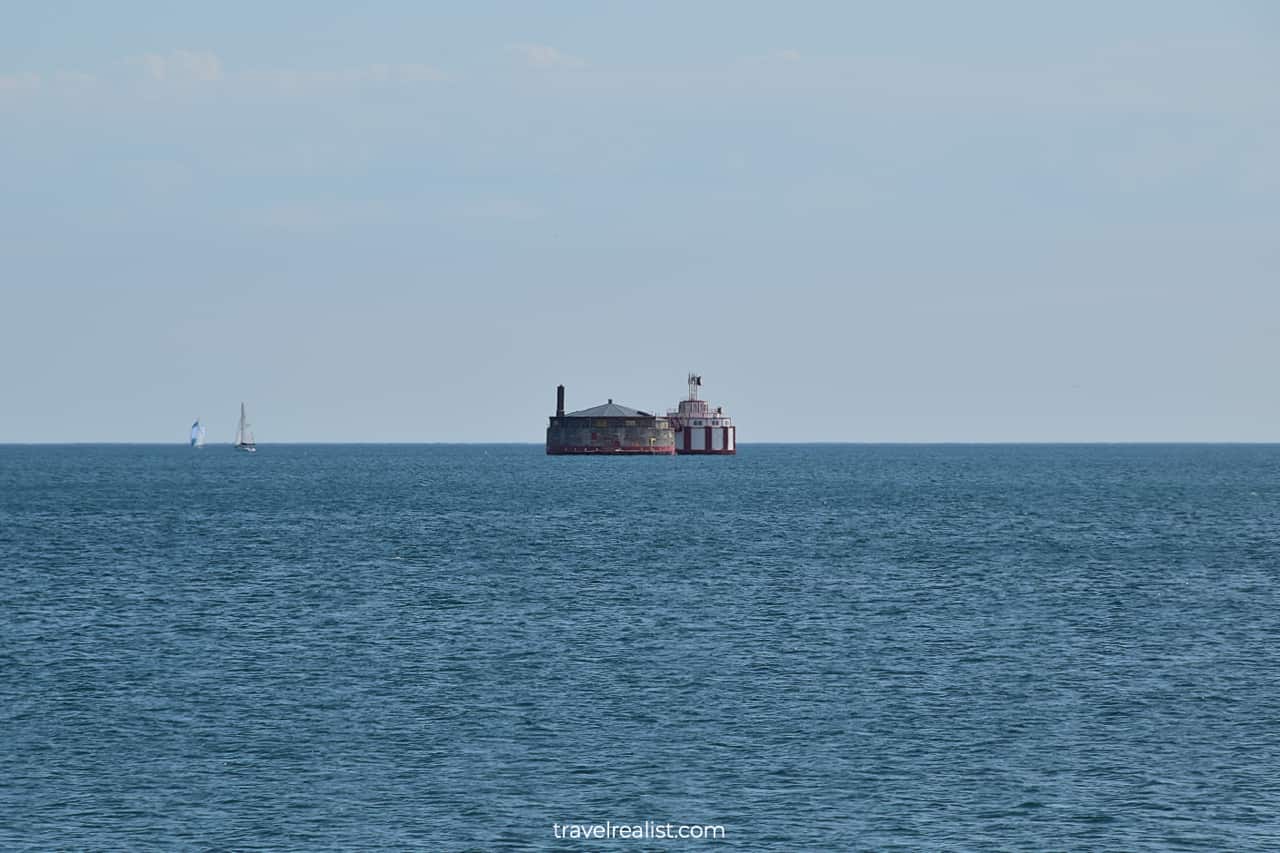
3.6. Chicago Harbor Lighthouse
The Lake Michigan Architecture Cruise brings you close to the 875 North Michigan Avenue Building. It then turns around and continues south along the Outer Breakwall.
You will go back to Navy Pier and the Hall. But this time you will be further away from the buildings. This is a good time to enjoy the lake breeze if you take this cruise in the summer.
You will then pass the Chicago Harbor Lighthouse. This lighthouse dates back to 1919 and is still in use. Rust shows the age of the structure. But it has held up well given the harsh climate at Lake Michigan.
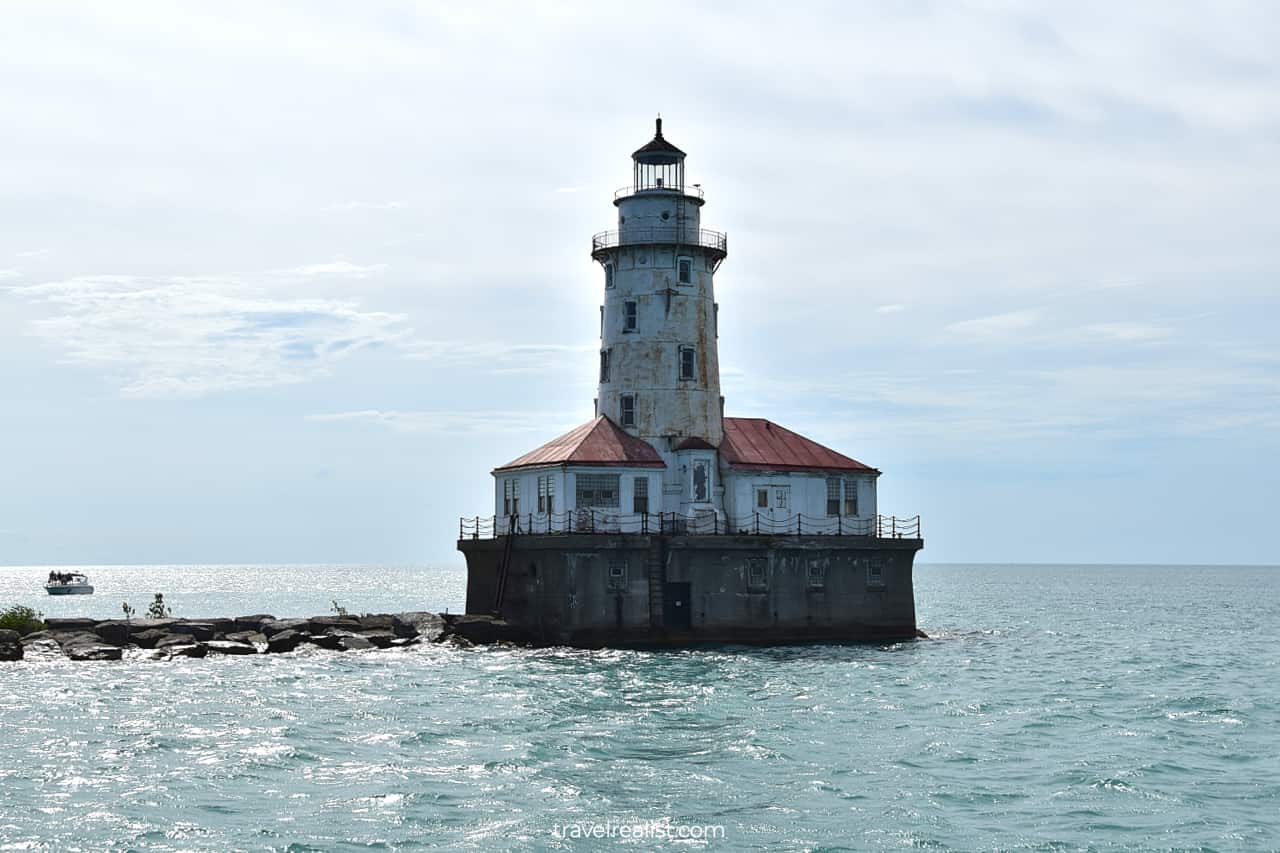
3.7. Buckingham Fountain
The cruise continues further south. As you leave the protection of the Outer Breakwall, the waves will become higher. This part of the cruise might not be enjoyable if you are prone to motion sickness.
On the bright side, you will see the famous structures onshore from a different angle. Here is a distant view of Buckingham Fountain. This fountain will be over at least a few miles (km) away.
But you will still be able to see it. The buildings on Michigan Avenue house museums, theaters, hotels, and restaurants.
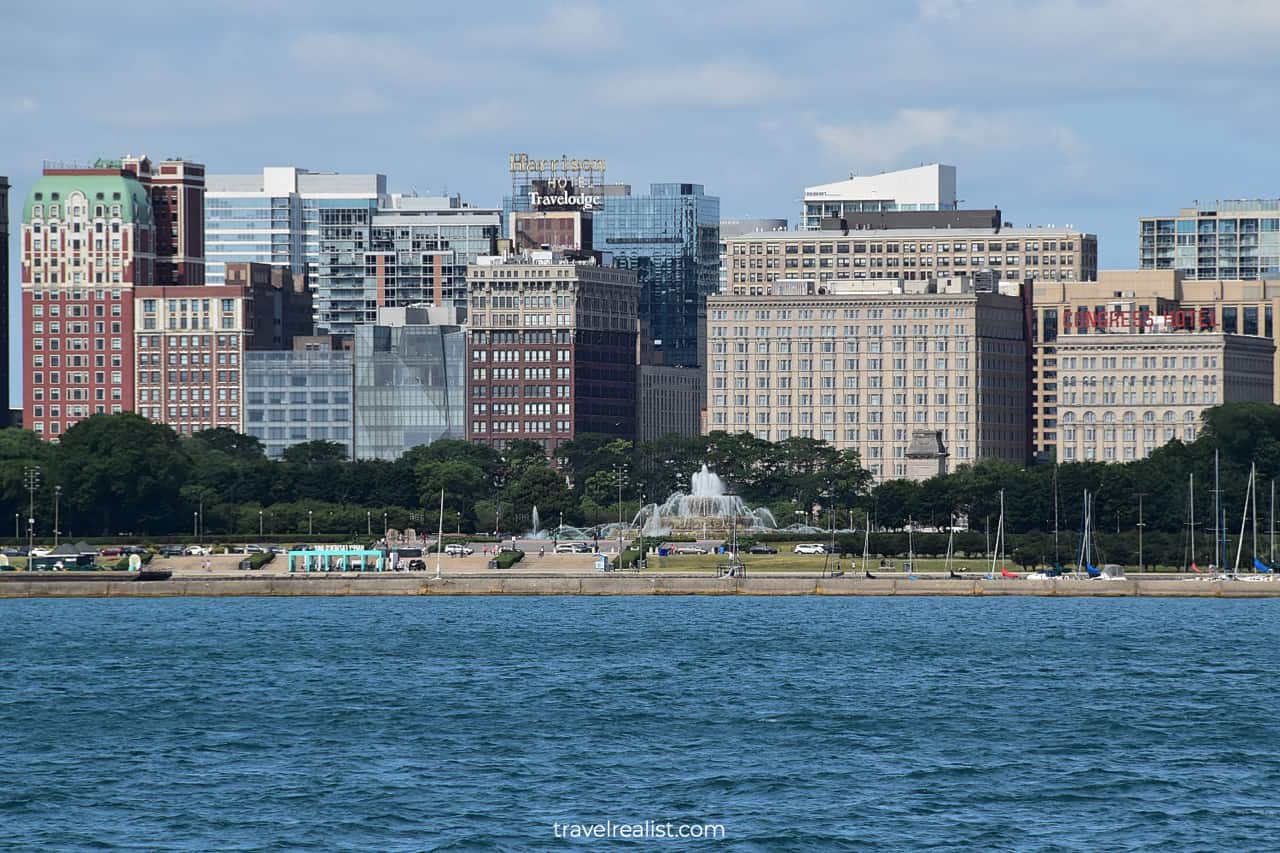
3.8. Chicago Skyline: Willis Tower
As you reach the furthest point of the Lake Michigan Cruise, you will get an amazing Chicago Skyline panorama. All of the tallest buildings in the city will be on full display.
The Willis Tower will dominate the view. This black rectangular skyscraper has been the tallest building in the city since its opening in 1973.
The city parks create a green belt near the lakeshore. Millennium Park, Maggie Daley Park, Grant Park, and Lakefront Park liven up the view.
The later park is home to the famous Lakefront Trail. This 18.5-mi (29-km) long paved multi-use path spans from 67th Street to Edgewater Beach. It is a favorite trail for many locals and visitors to Chicago.
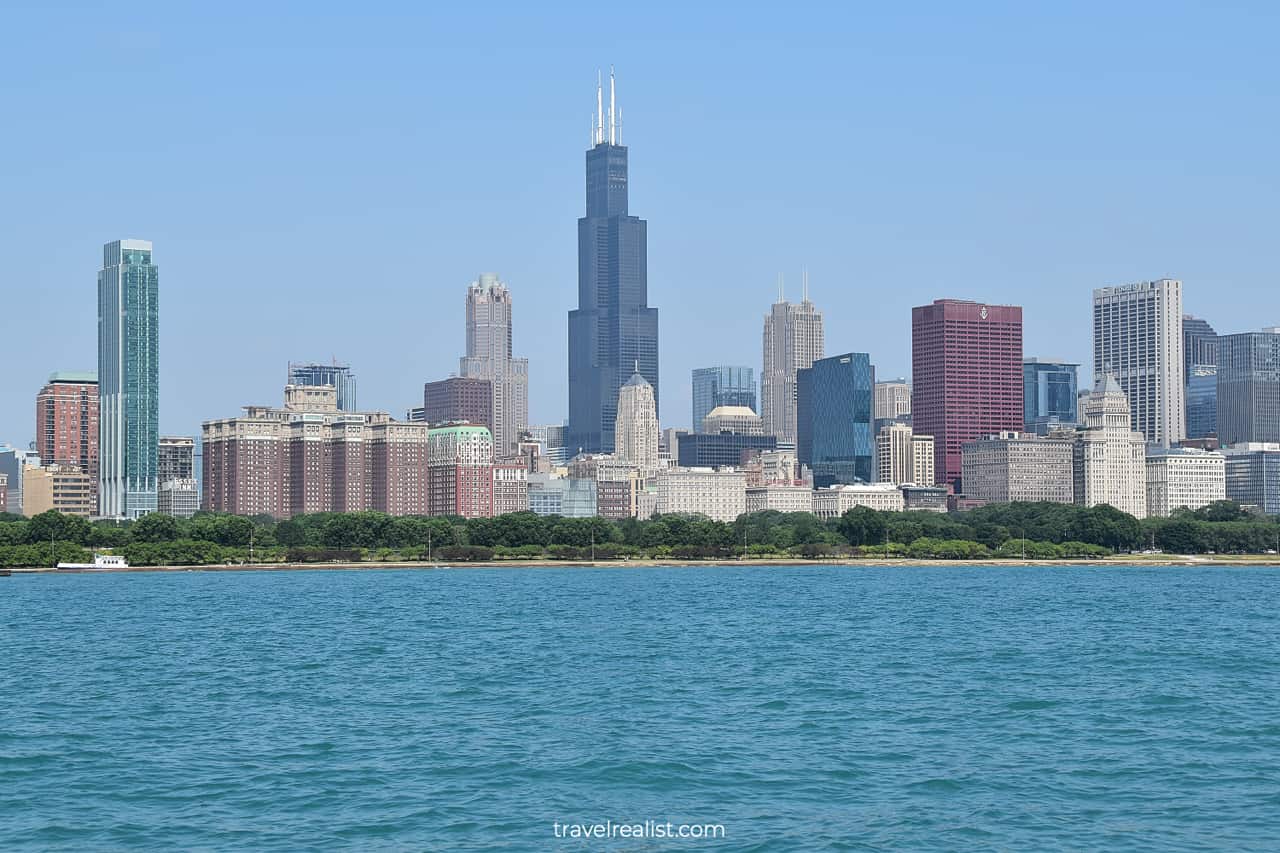
3.9. Chicago Skyline: Aon Center & St. Regis Chicago
You will see the other tallest buildings in Chicago as you look north. Trump International Hotel and Tower is the second tallest building. St. Regis Chicago, a condominium tower, claims the third spot.
These skyscrapers were both complete in the 21st century. St. Regis Chicago is the latest addition to city skyline. This building opened its doors in 2020.
The fourth and fifth tallest buildings in Chicago will be also in sight. The Aon Center and the John Hancock Center (875 North Michigan Avenue) both date back to the 1960s and 1970s.
Two Prudential Plaza is another notable skyscraper. But the building height is only partially responsible for its iconic status. Instead, you could quickly recognize its pyramid peak and stacked chevrons.
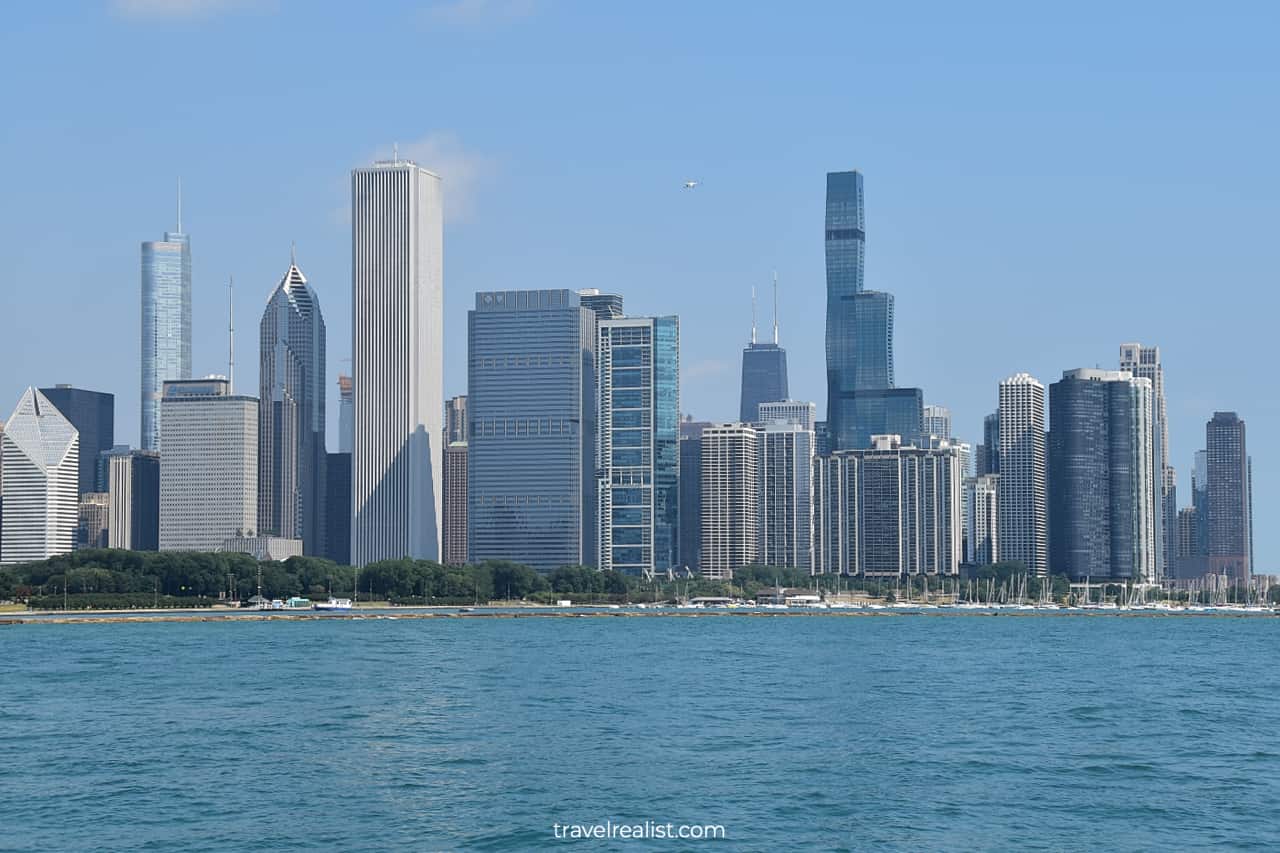
Once you had a chance to admire the city architecture from afar, the Lake Michigan Architecture Cruise turns back. It returns to Navy Pier before going through the Chicago Harbor Lock again.
The cruise boat passes a handful of the buildings you just saw before docking at the Michigan Avenue terminal. This is the end of the Lake Michigan Architecture Cruise.
4. Hyde Park Architecture Tour by Train
You saw the main architectural landmarks of Chicago on a walking tour, a river cruise, and a Lake Michigan cruise. But the city has plenty of other architectural wonders.
Most of them are just a short subway or train ride away. You could choose to go north to Lincoln Park and see its Zoo, Café Brauer, and Conservatory.
You could hop on a Green Line train and go to Oak Park. This is a known architectural center that includes Frank Lloyd Wright House & Studio and Ernest Hemingway Birthplace Museum.
You could walk around Oak Park and see lots of Frank Lloyd Wright designs. You could combine this trip with a visit to Garfield Park Conservatory.
Oak Park has so many sights that you would need a separate day trip to explore all of them. But there is one other area of Chicago you should visit if you enjoy architecture.
Hyde Park is a beautiful neighborhood south of Chicago Loop. It is home to the University of Chicago and Frederick C. Robbie House.
Take a Metra Electric (ME) train to University of Chicago/59th Street station. You will get there in 17 minutes from Millenium Station. A one-way ride costs $4.25. Get a $6 day pass to save on a ride back.
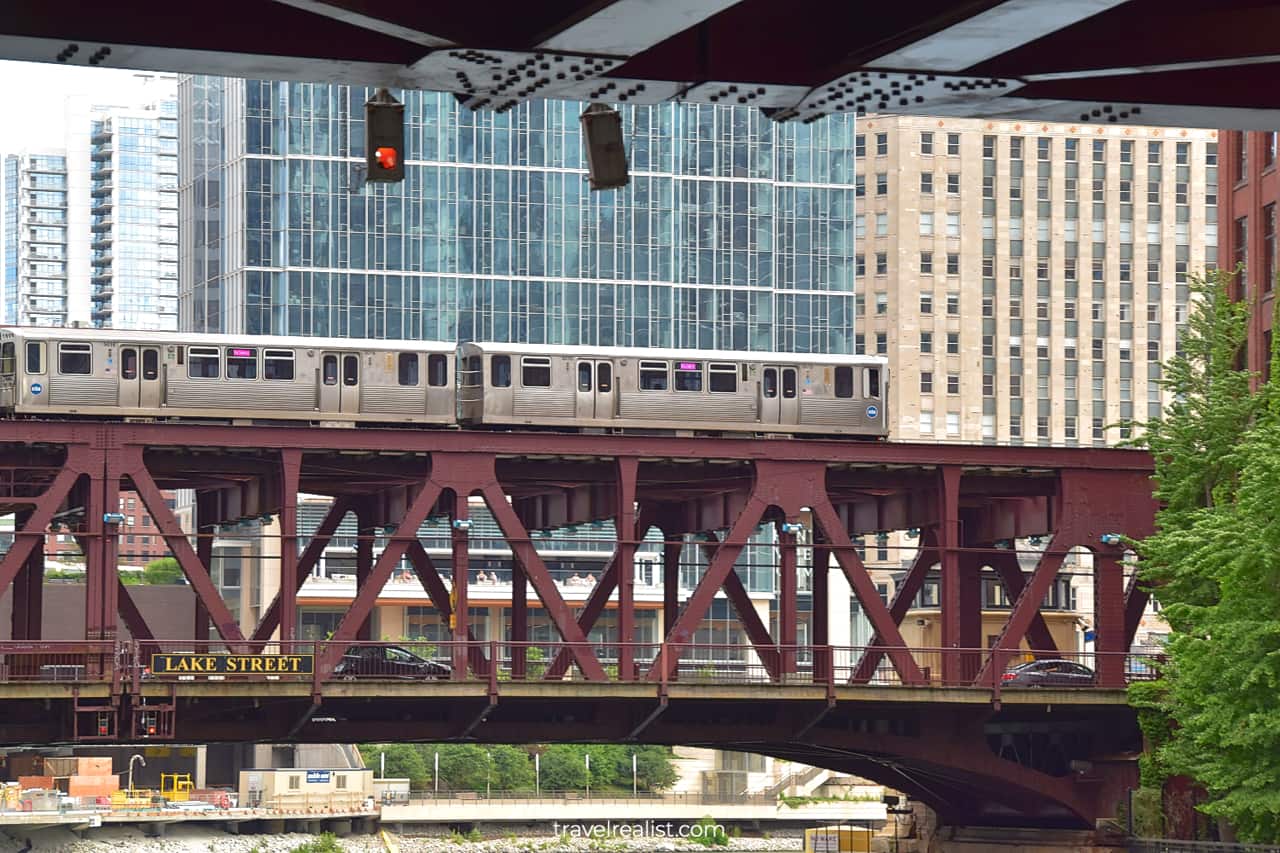
4.1. Museum of Science and Industry
It could be a good idea to first go east, towards Lake Michigan. You will find yourself in Jackson Park. As an architecture lover you could enjoy the Museum of Science and Industry.
This museum is in the Palace of Fine Arts that dates back to 1893 World’s Columbian Exposition. The exposition origin makes this building similar with the Palace of Fine Arts in San Francisco, California.
The Chicago Palace of Fine Arts is made of brick with a plaster facade. Its ancient Greek and Roman inspired exterior is common throughout the US, from Boston and D.C. to Nashville and Austin.
Jackson Park houses Garden of the Phoenix on Wooden Island. East and West Lagoons surround the island. It is an amazing place to enjoy cherry blossom in the spring.
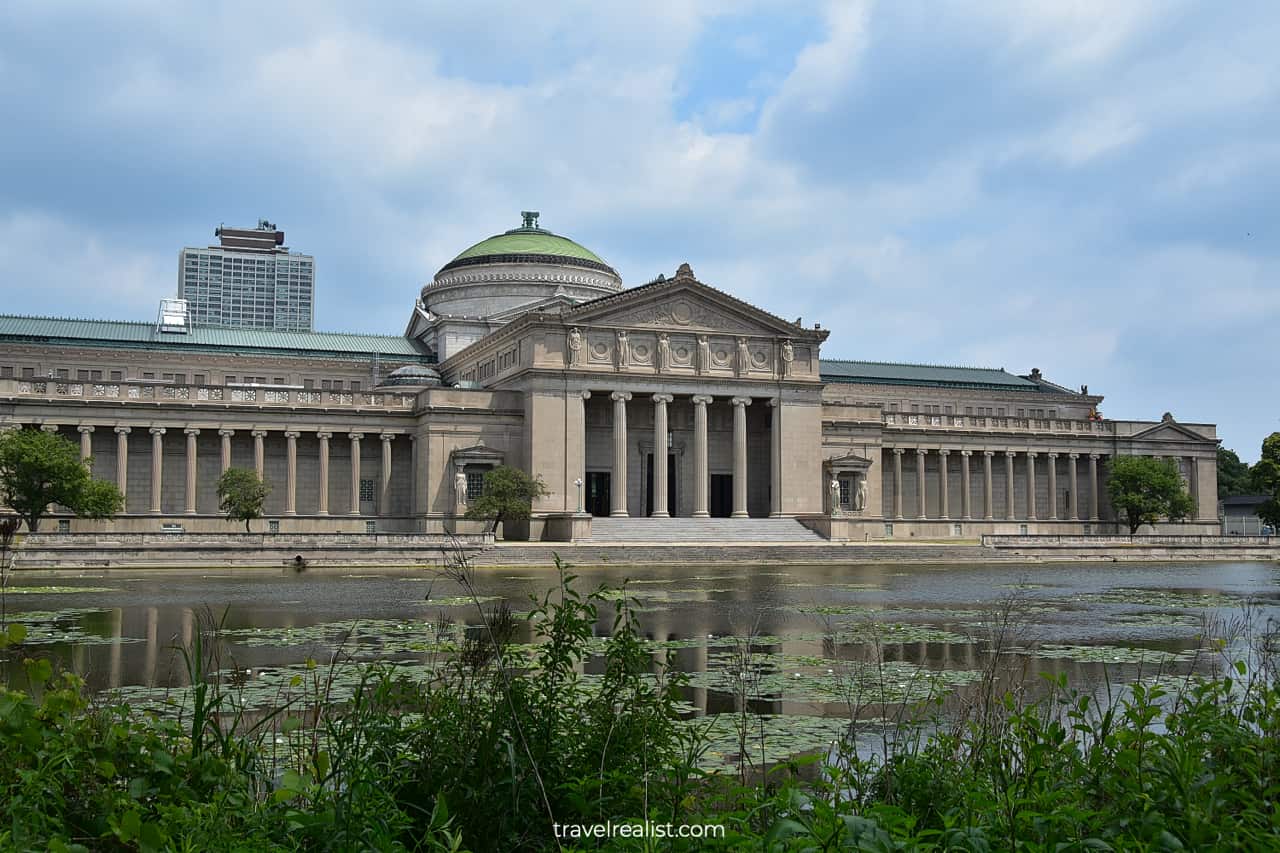
4.2. Robie House by Frank Lloyd Wright
After a quick stop in Jackson Park, you should continue with the self-guided architecture tour of Hyde Park. You will reach the Frederick C. Robie House, or simply the Robie House, in 0.8 miles (1.3 km).
This building by Frank Lloyd Wright is one of the best examples of the Prairie School of Architecture. The house dates back to 1910.
You could enjoy this National Historic Landmark from 58th Street or Woodlawn Avenue any day of the year. But you would need to book a guided tour to see the house interior.
The house is open to visitors from Thursday to Monday from 10 a.m. to 2:30 p.m. The main house tour takes 45 minutes and costs $20.
This tour often sells out. You should book a spot in advance. In this case, you should plan your day around a visit to this house museum.
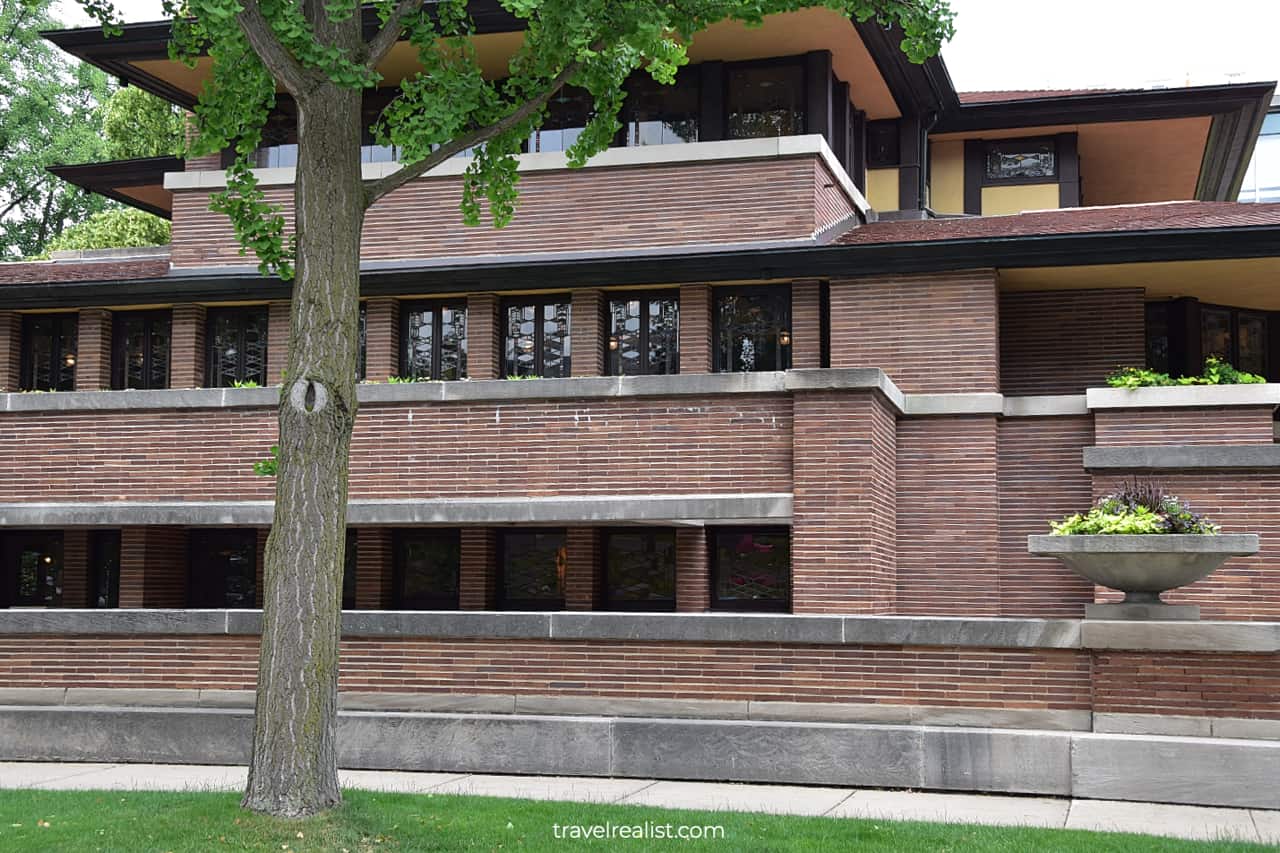
4.3. University of Chicago
The Robie House is on campus of the University of Chicago. This campus has a handful of modern and historic buildings. A few of them are true architectural masterpieces.
4.3.1. Rockefeller Memorial Chapel
Rockefeller Chapel is across the street from the Robie House. The chapel is an example of Collegiate Gothic architectural style.
This style is common across North American universities, like Yale and Cornell. Interestingly, Harvard and MIT were built in a Neo-Classical architectural style.
Rockefeller Chapel is the tallest building on campus. You will be able to see it from Midway Plaisance Park, Woodlawn Avenue, and a handful of other areas.
The chapel dates back to 1928. It makes it nearly 18 years younger than the nearby Frederick C. Robie House. You did not see that coming, did you?
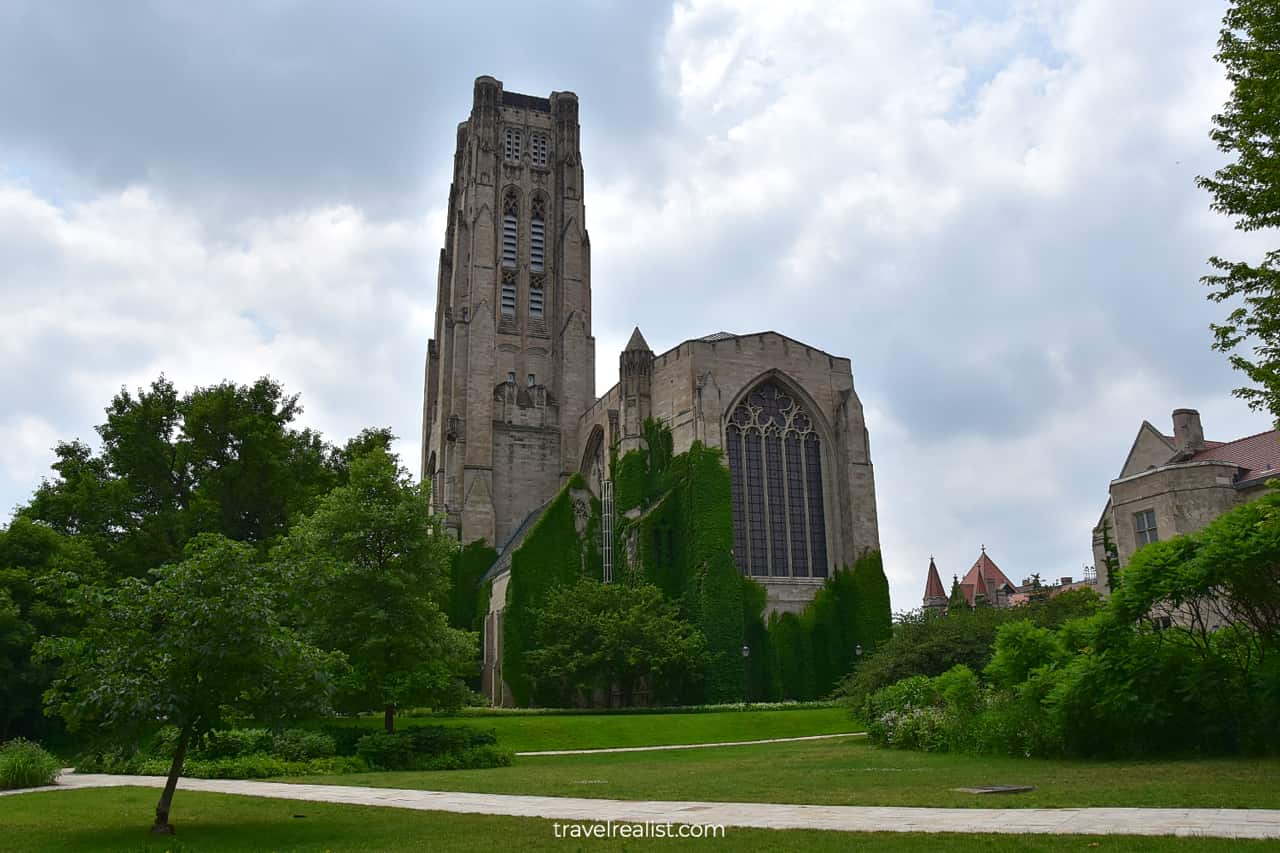
4.3.2. Saieh Hall For Economics
Take a walk around the chapel. As you return to the intersection of Woodlawn Avenue and 58th Street, you will arrive at Saieh Hall for Economics.
This is another Collegiate Gothic building thanks to a bell tower. The part of the building with the tower dates back to 1928.
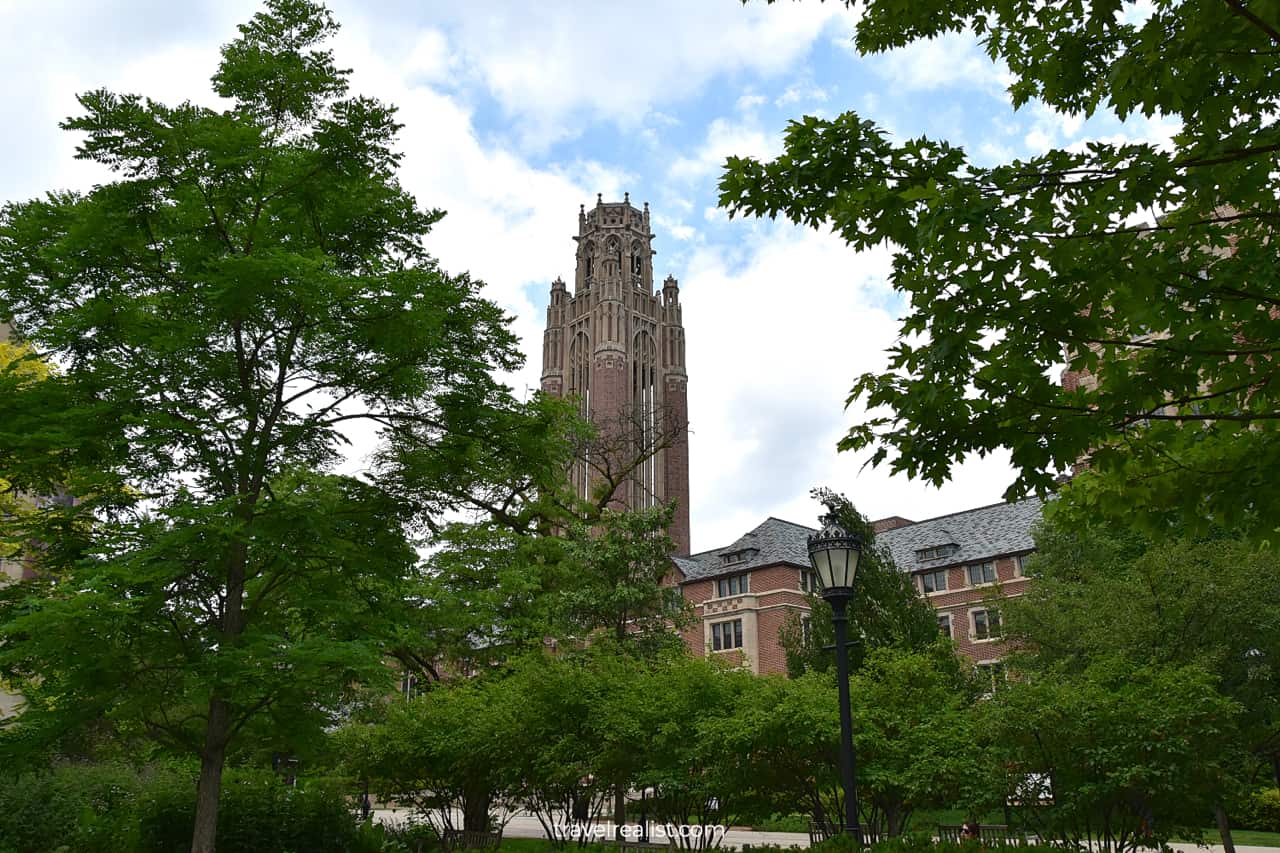
4.3.3. Ryerson Laboratory
You will enter the Main Quadrangle of the University of Chicago if you walk a block west. This large square is home to a few historic campus buildings.
Ryerson Laboratory is the closest building to University Avenue. It was a research center under the Manhattan Project.
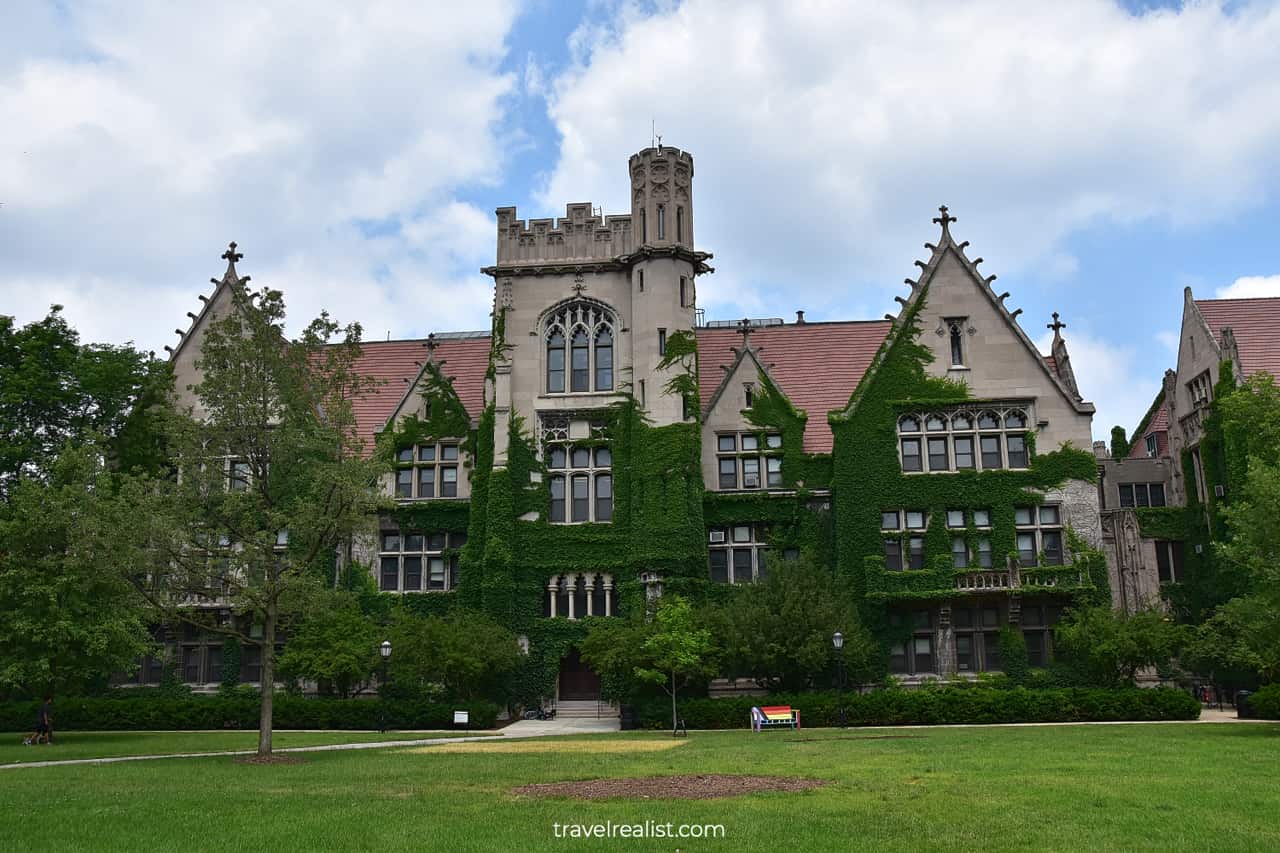
4.3.4. Rosenwald Hall
You should turn south from the Main Quadrangle to the Harper Quadrangle. The latter houses a few more architectural landmarks.
Rosenwald Hall is the first of them. You could spot this building thanks to its round tower. It now houses the University of Chicago Admissions Center.
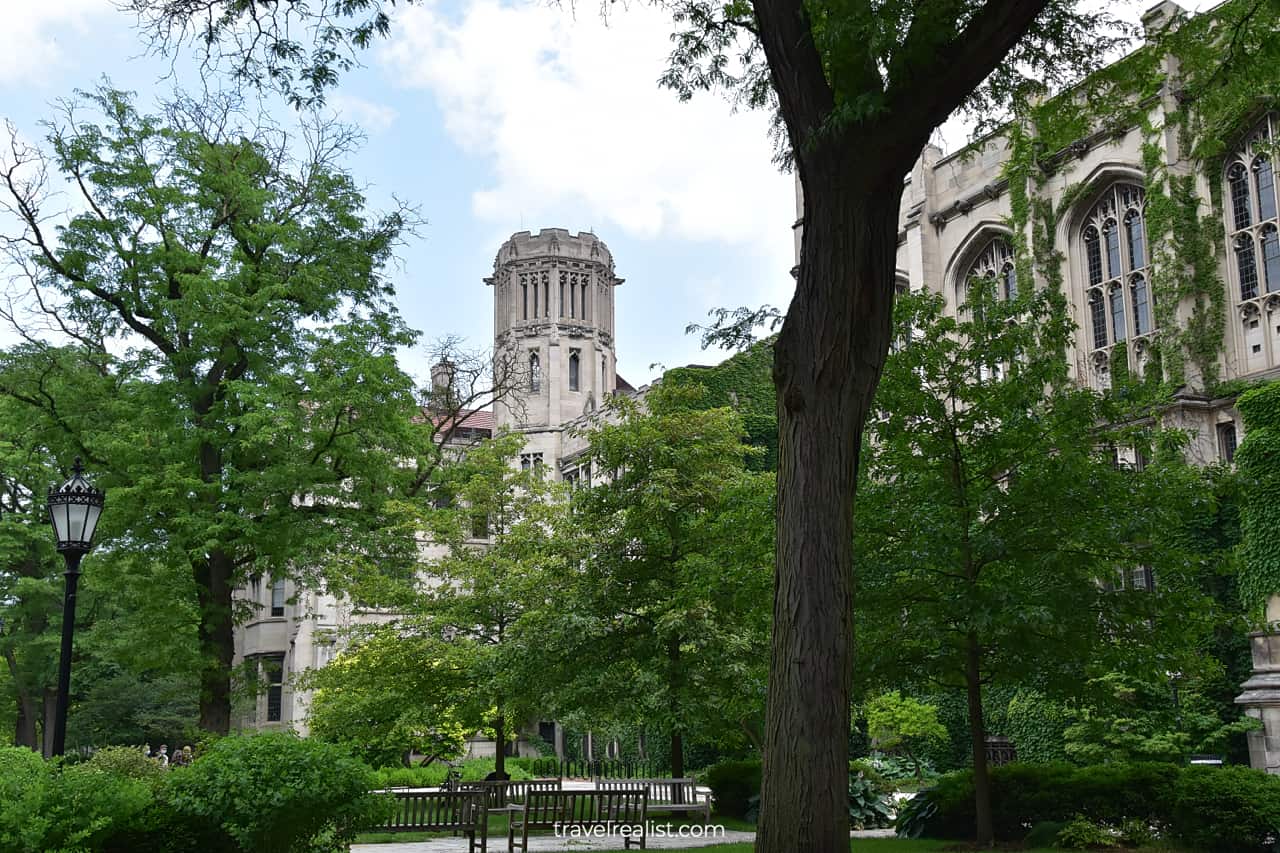
4.3.5. Stuart Hall
Stuart Hall is an ivy covered building on the same side of the Harper Quadrangle as Rosenwald Hall. It has beautiful Gothic windows and doorways.
Stuart Hall connects to Harper Memorial Library via a covered passage. Students and faculty members certainly appreciate this design element during cold Chicago winters.
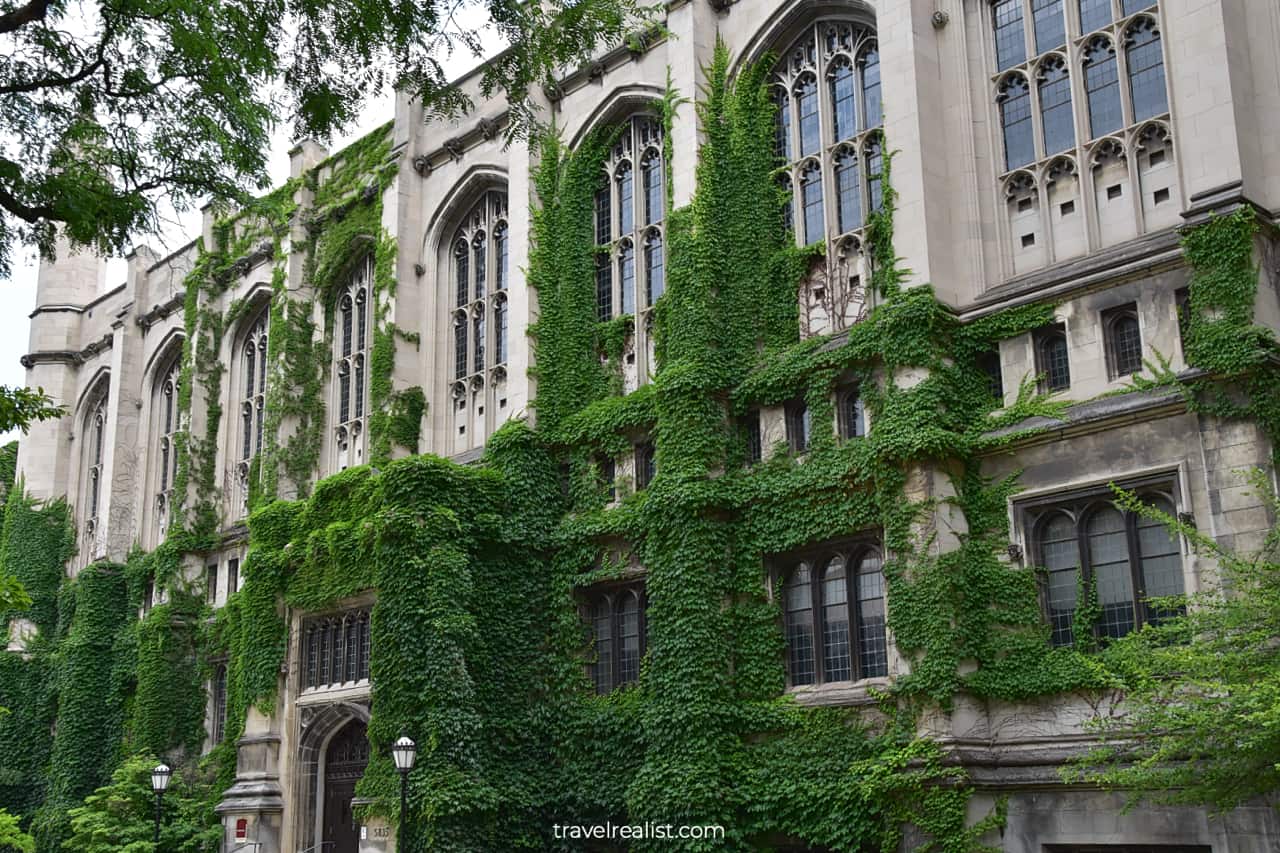
4.3.6. Haskell Hall
Haskell Hall is the building opposite Stuart Hall. This building looks a bit like Ryerson Laboratory in the Main Quadrangle. It has similar Gable Roof elements and beautiful red shingles.
You could choose to take one of the passages to 59th Street. Head to the Carl von Linne Monument. You could enjoy the views of Harper Memorial Library from North Winter Garden.
If you like contemporary architecture, you should head to the Joe and Rika Mansueto Library. This building is a couple of blocks north from Midway Plaisance.
Other buildings on campus are not as scenic. You could choose to go to Cottage Grove subway station or return to University of Chicago/59th St train station. Either would bring you back to the Chicago Loop.
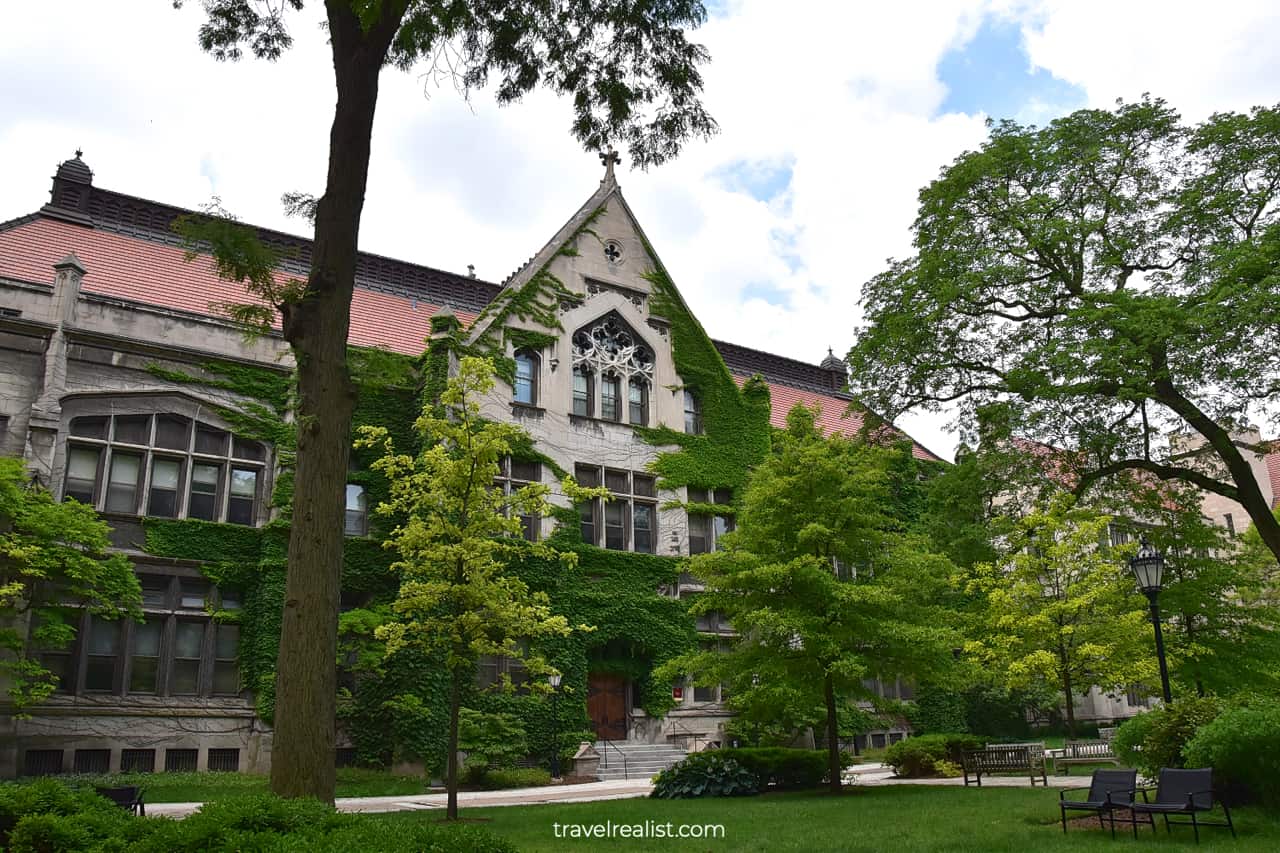
Continue with this Chicago Architecture Comprehensive Guide. You will learn more about ways to get to the sights, entrance requirements, and places to stay.
Getting to Chicago
Any exploration of Chicago Architecture has to start with the Loop. Thankfully, you could reach this neighborhood in a number of ways, by car and by public transport.
It could be tempting to rent a car at Chicago O’Hare (ORD) or Midway (MDW) airports. The Loop is just a short 30-minute drive from either airport without traffic.
But a rental car might not be a good idea. Parking is limited and gets quite expensive. A rideshare or public transport could be a better way to the Loop.
An Orange L train will bring you from Midway airport in 35 minutes. It costs $2.5 each way. Consider getting a day pass at $5. A Blue L train from O’Hare airport takes nearly an hour and costs $5.
Buses and trains work best if you live in Chicago Area. But you could board a Metra train to Hyde Park if you extend your exploration.
A Metra Electric (ME) train is the fastest way to this neighborhood. A 17-minute ride costs $4.25. The service is less frequent on weekends.
Last but not least, do not dismiss a good old bike. The Lakefront Trail and bike lanes make it a viable option. You could rent a Divvy bike in Chicago right from your Lyft profile.
A day pass costs $16.5 per day. You could take a 3-hour ride before needing to return a bike to a station. There are stations all over the Chicago Loop, Near North Side, and Hyde Park.
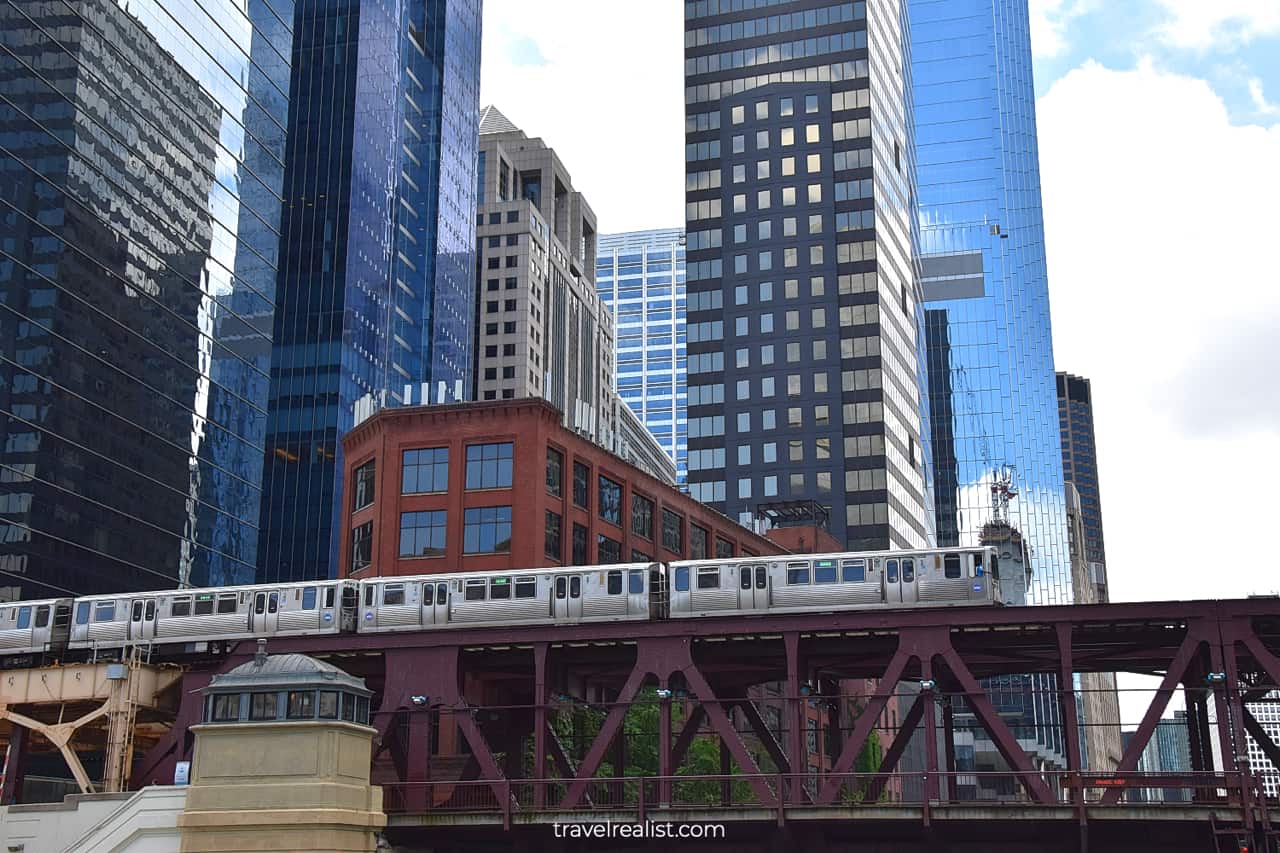
Where to Stay to See Chicago Architecture
There is no better neighborhood than the Chicago Loop to stay in to see Chicago architecture. The tallest buildings of the city are either in the Loop or in the Near North Side.
The Loop also has a great connection to both airports and most neighborhoods via public transport. You could take a train to Hyde Park or a subway to Oak Park. Their landmarks are less than 30 minutes away.
You cannot go wrong if you stay at Hotel Blake, an Ascend Hotel Collection Member. This hotel is minutes from Willis Tower, Buckingham Fountain, subway and train lines.
You could also stay in Navy Pier. This location is less convenient for a self guided walking tour and public transport connection. But you could take a Lake and River Cruise almost from your hotel.
If you are traveling on a budget, check out places to stay just south and north of the Loop. These properties tend to be a little more affordable.
SpringHill Suites by Marriott Chicago Chinatown is a solid choice in the south. Hyatt Place Chicago Wicker Park is a good option up north.
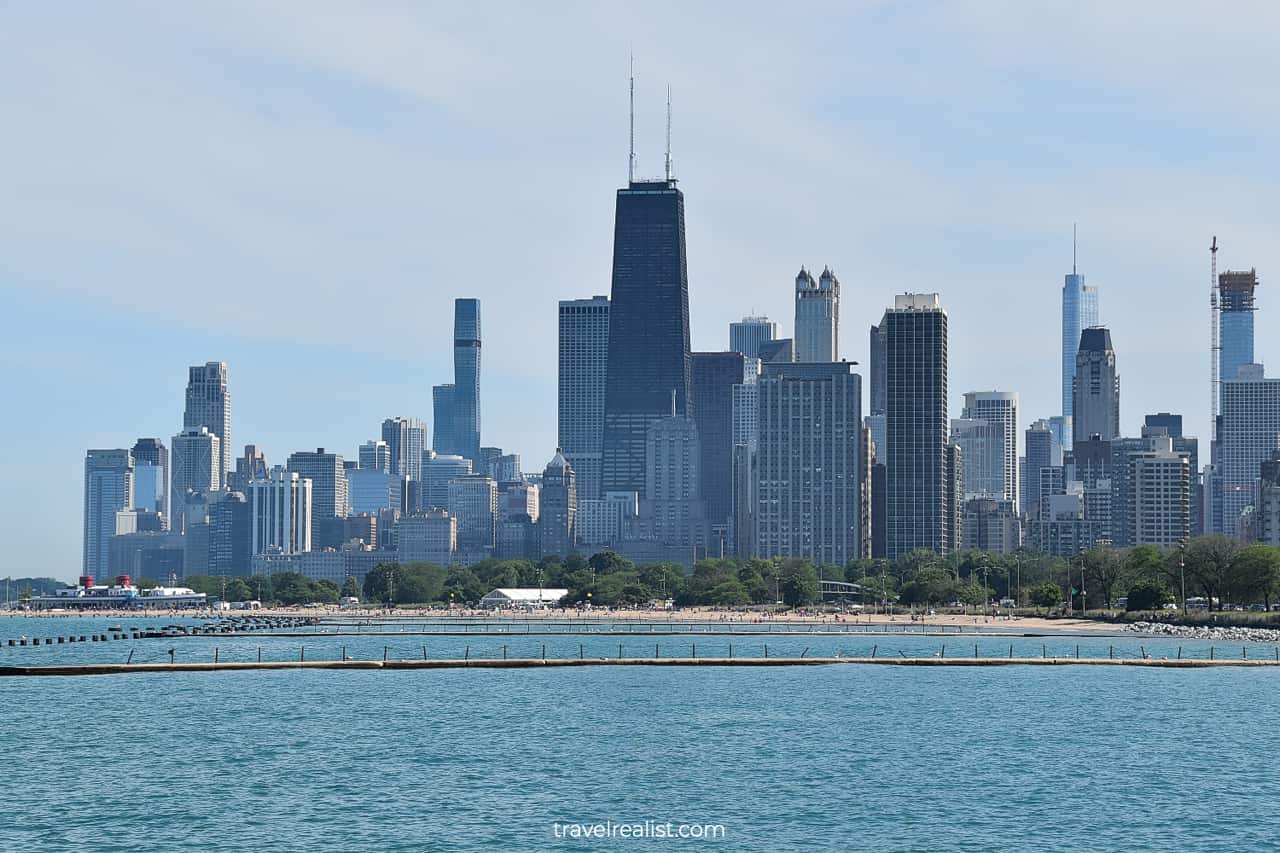
Entrance Requirements & Passes
You could admire Chicago Architecture from the outside on a walking tour any day of the year. But you would need to adhere to the opening hours if you would like to explore any structures closer.
- Millenium Park: open from 6 a.m. to 11 p.m., free admission
- Grant Park: open from 6 a.m. to 11 p.m., free admission
- Skydeck Chicago at Willis Tower: open from 9 a.m. and 10 p.m (8 p.m. in winter), $46 per adult
- 360 Chicago: open from 9 a.m. to 11 p.m., $30 per adult
- Jackson Park: open from 6 a.m. to 9 p.m., free
- Robbie House: open to guided tours Thursdays to Mondays, $20 per adult
Chicago River and Lake Architecture Cruises are very different depending on the provider. The starting location and cruise route are the only common items.
But you cannot say the same about schedule and prices. Both are also subject to change with little notice.
In general, you should expect to pay at least $42 per adult for a river cruise. A Lake Michigan cruise will cost at least $40 per adult.
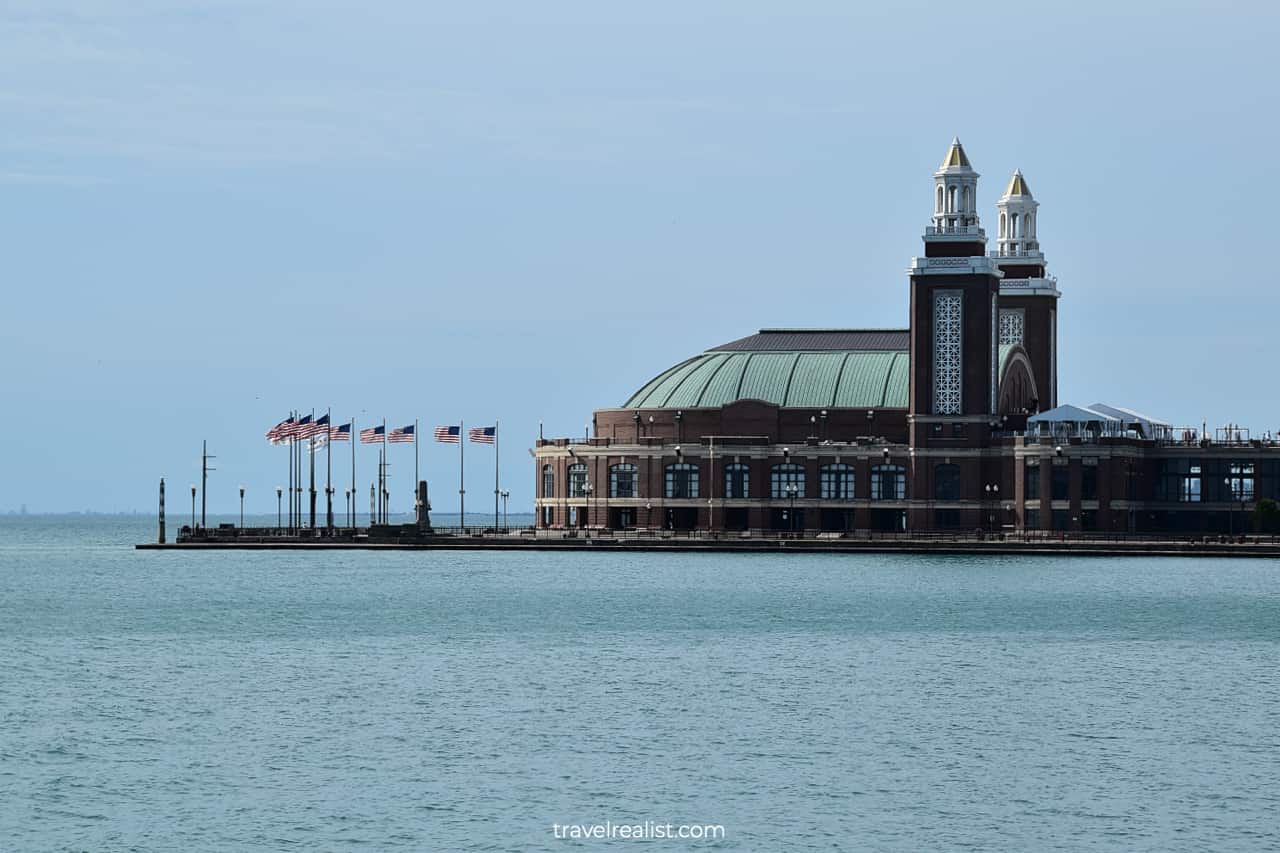
Takeaways: Chicago Architecture
Chicago, Illinois is a city with the long-standing architectural traditions. Different styles, elements, and materials make Chicago a unique destination for architecture lovers.
But you do not have to be a geek to enjoy the historical buildings. There are plenty of other, more accessible ways to interact with the city.
Just take a stroll through Millennium Park and enjoy Buckingham Fountain. Or see the city from atop the Willis Tower or the former John Hancock Building.
Maybe you choose to board a river cruise and see the structures from a boat. Or head out to the open waters of Lake Michigan to see the skyline and fireworks.
Regardless of the way you choose to explore Chicago, remember to enjoy this beautiful industrial city. And layer up to stop worrying about the famous wind chills.
Take a look at this Chicago Architecture Comprehensive Video Guide. And visit the YouTube channel for the latest videos.
Frequently Asked Questions
Chicago Architecture boat tours have different starting locations depending on the tour operator. Most tours start at the docks at Michigan Avenue, Ogden Slip, Navy Pier, and South Loop.
Chicago Architecture boat tours differ in duration. The shortest tour is just 45 minutes. Most tours are either 75 minutes or 90 minutes.
A few Chicago Architecture boat tours are in the running for the best title. Tour schedule, duration, price, dock location, and route all play a role.
– It is hard to rival Wendella in price per minute: its 90-minute cruise costs $42 per adult.
– Most other tour operators offer 75 to 90-minute tours starting at $40 per adult.
– $49 per adult is the most common price for such a tour.
– Wendella and CityExperiences offer the most affordable tours.
– Chicago’s First Lady and Chicago Line Cruises are the most expensive.
Here are the structures to see on a self-guided Chicago Architecture walking tour:
The Loop
– Millennium Park with Cloud Gate
– Grant Park with Buckingham Fountain
– Willis Tower with Skydeck
– Civic Opera House
Near North Side
– Wrigley Building
– Tribune Tower
– Merchandise Mart
– Reid Murdoch Building
– Jewelers Building
– 875 North Michigan Avenue with 360 Chicago
– Lincoln Park Conservatory
Hyde Park
– Robbie House
– University of Chicago
Oak Park
– Frank Lloyd Wright Home & Studio
– Ernest Hemingway Birthplace Museum
– Garfield Park Conservatory
Safe realist travels!

